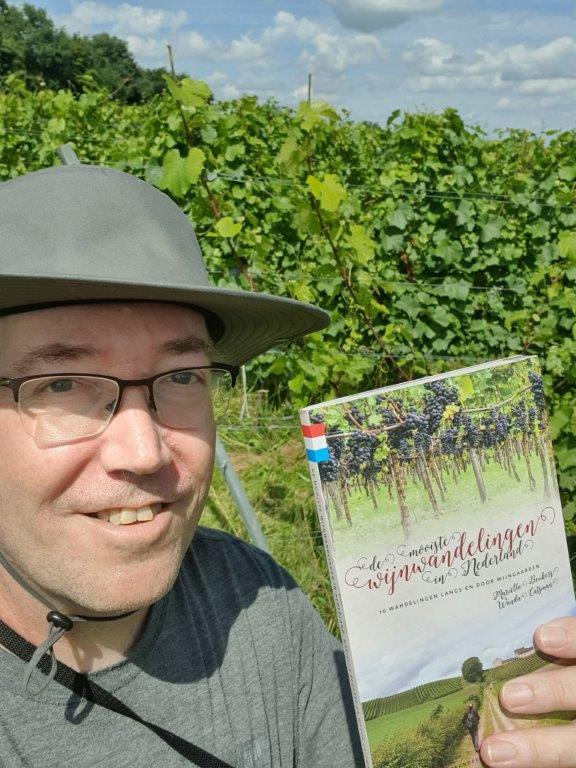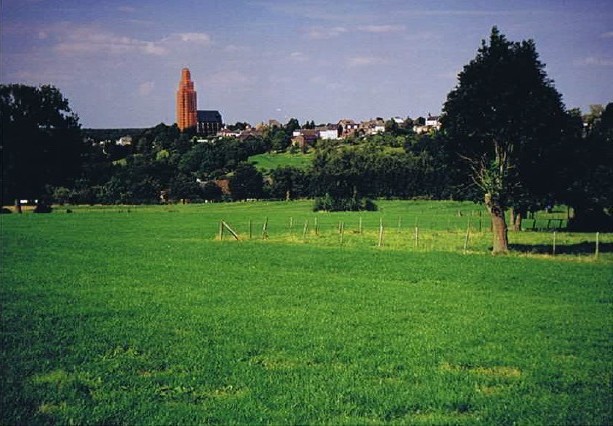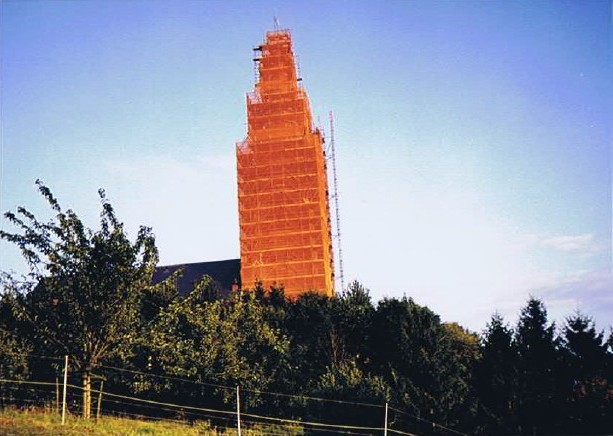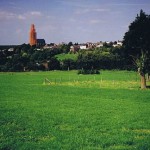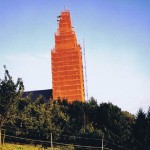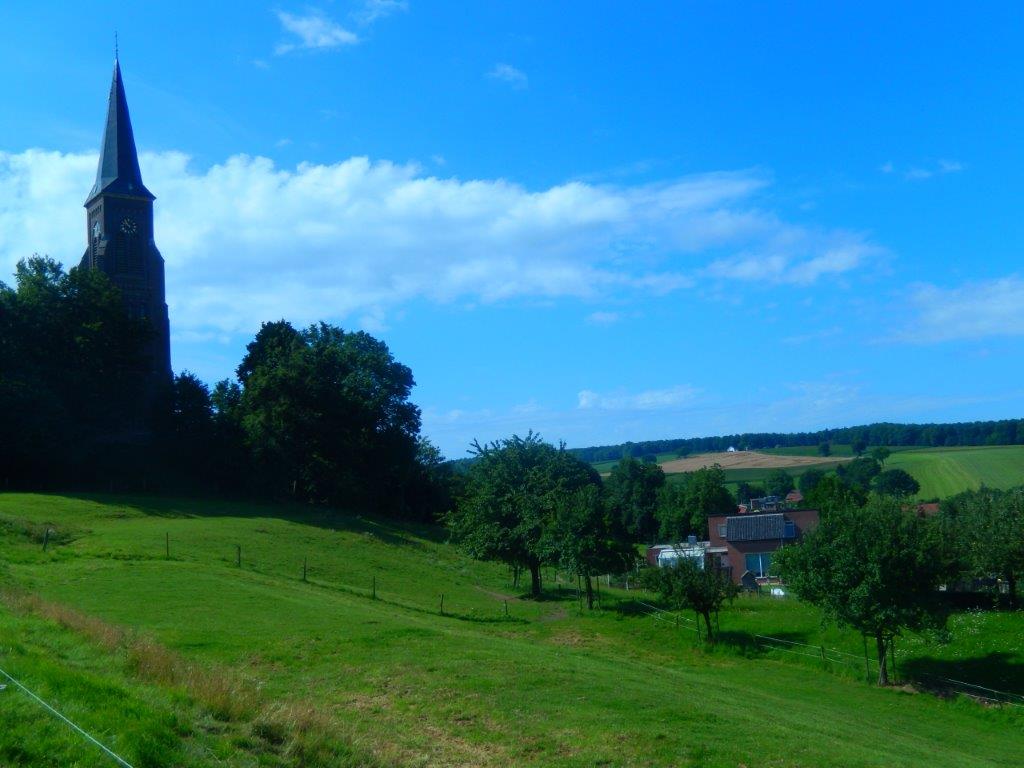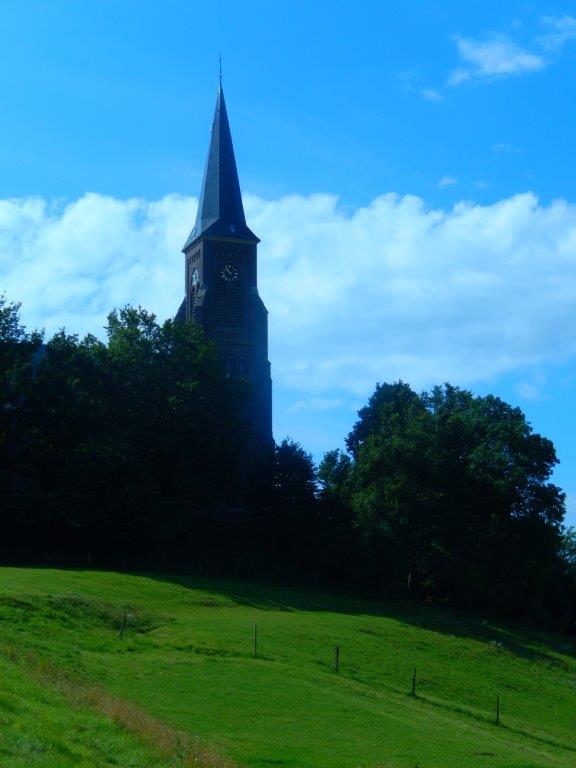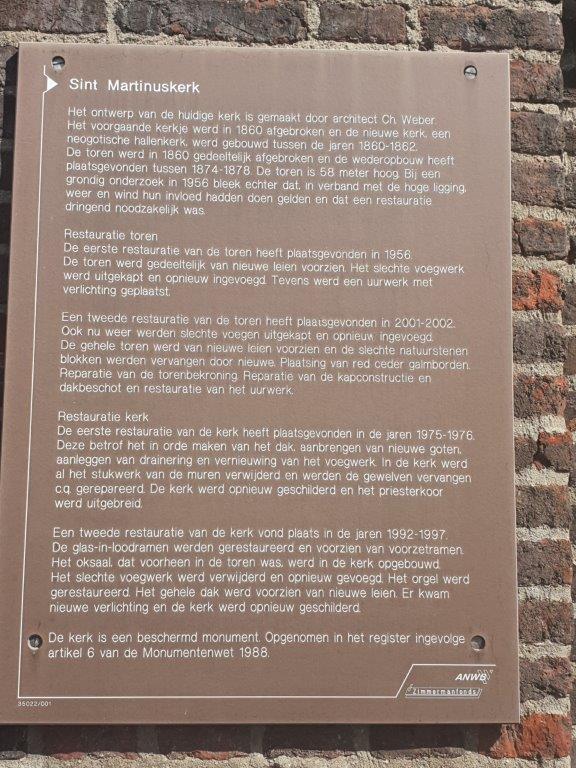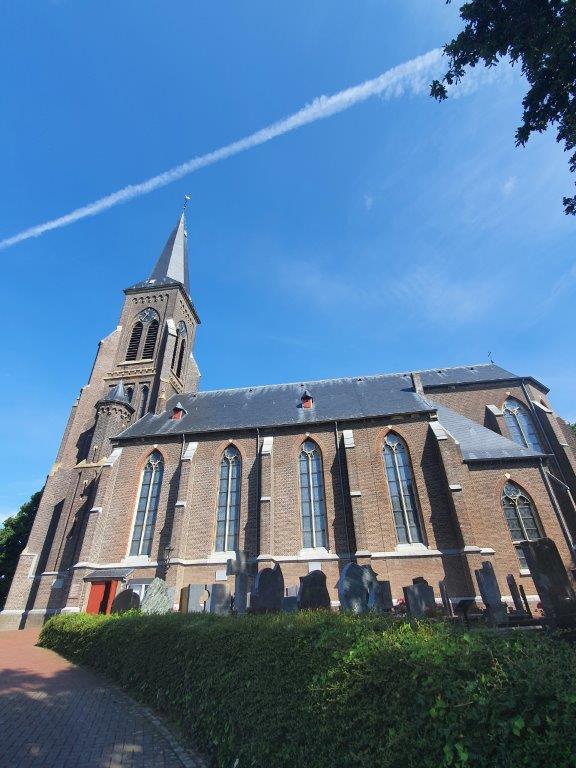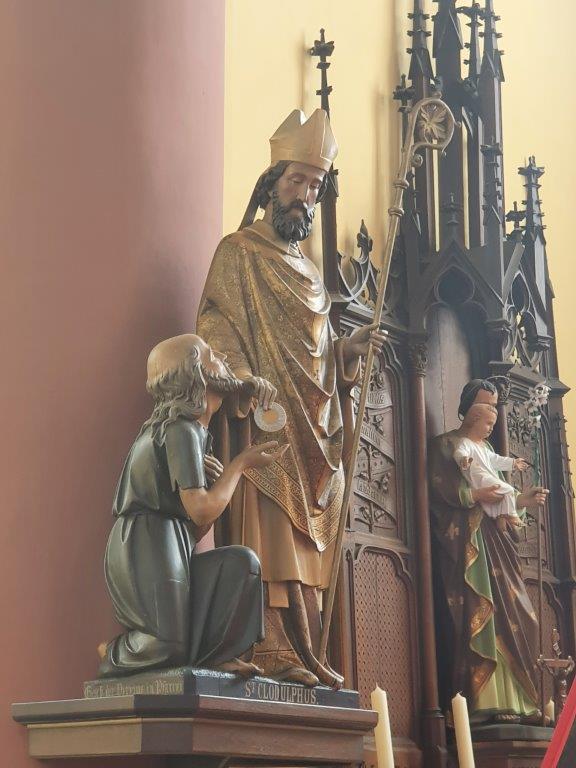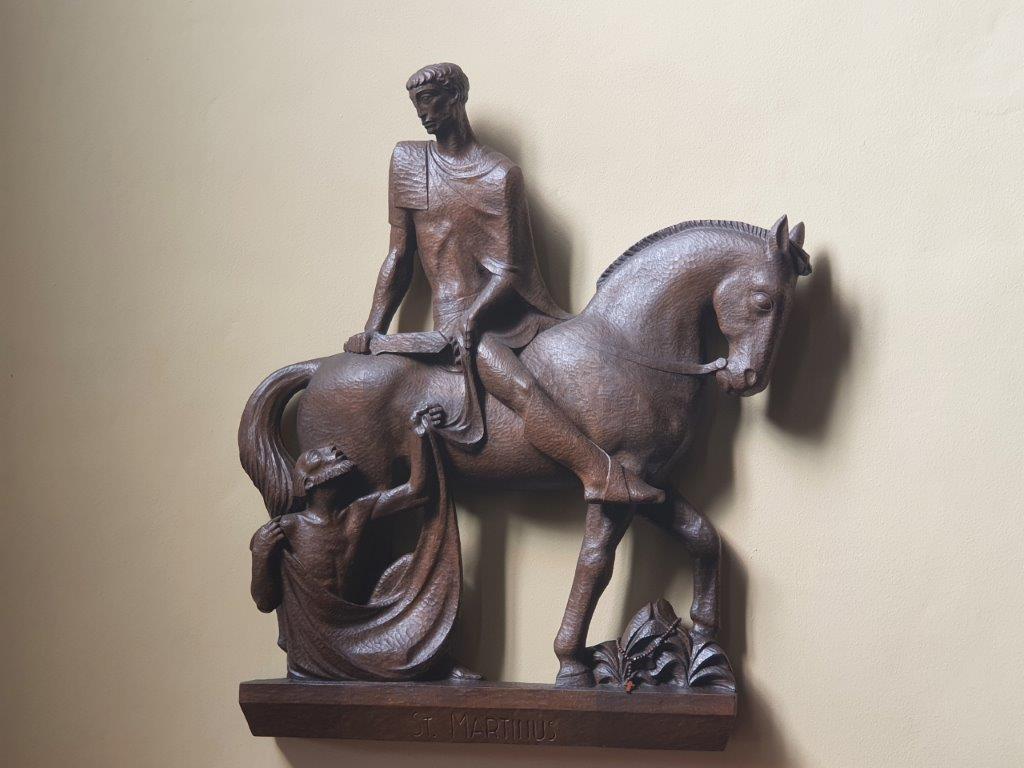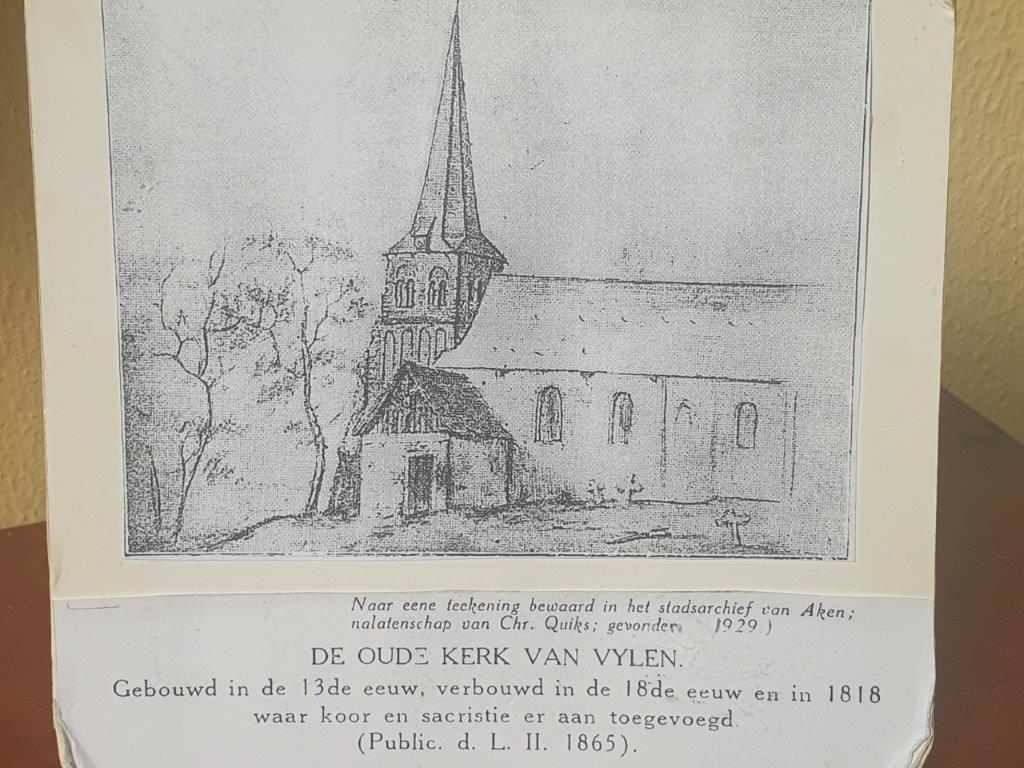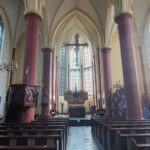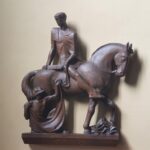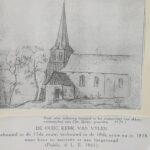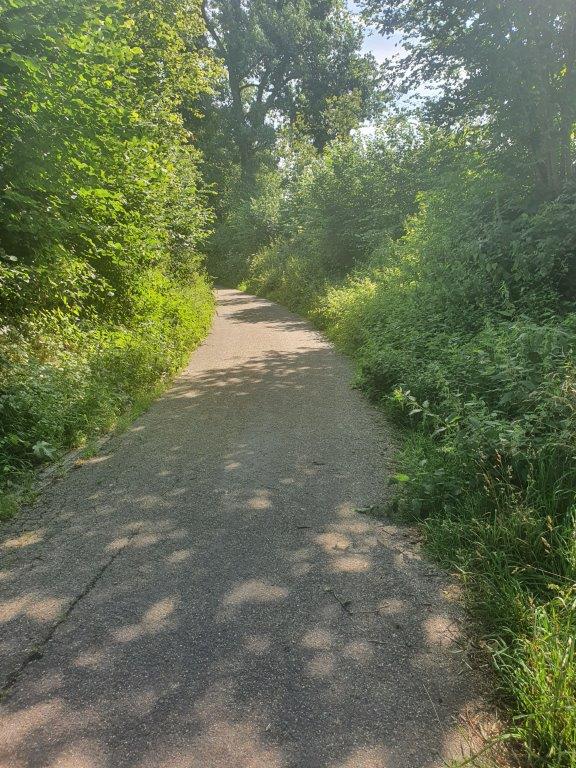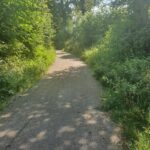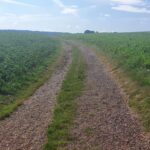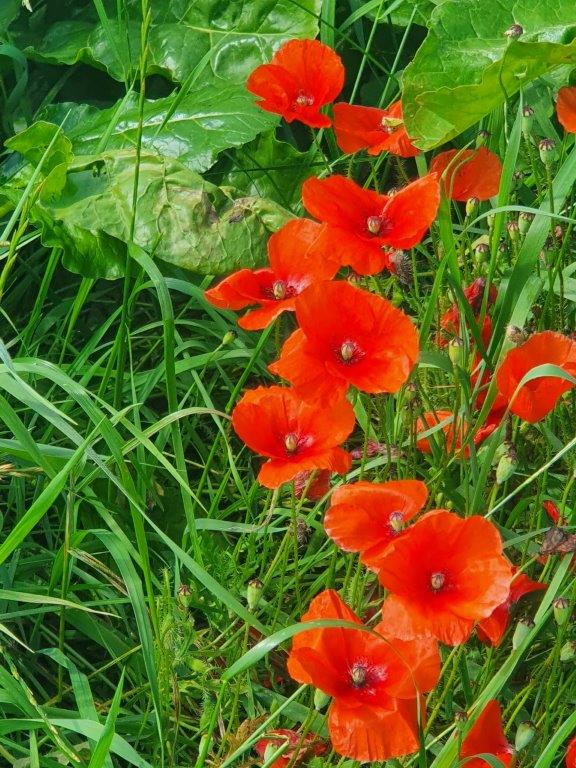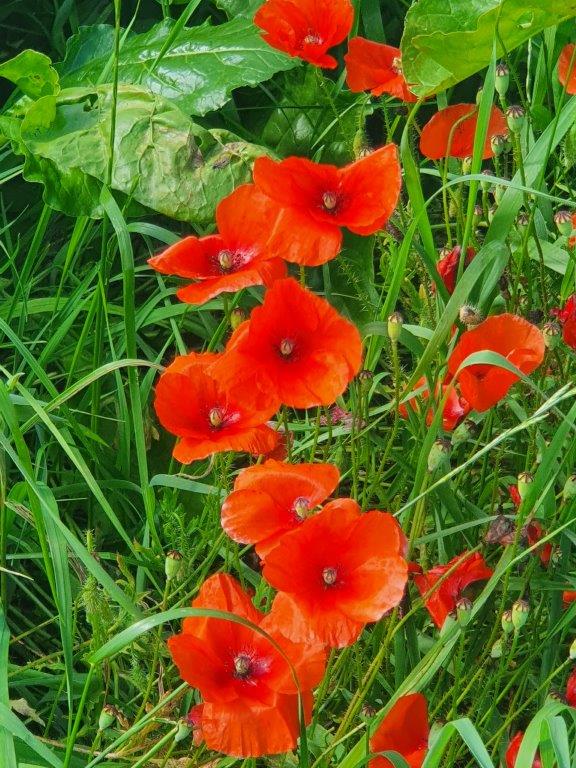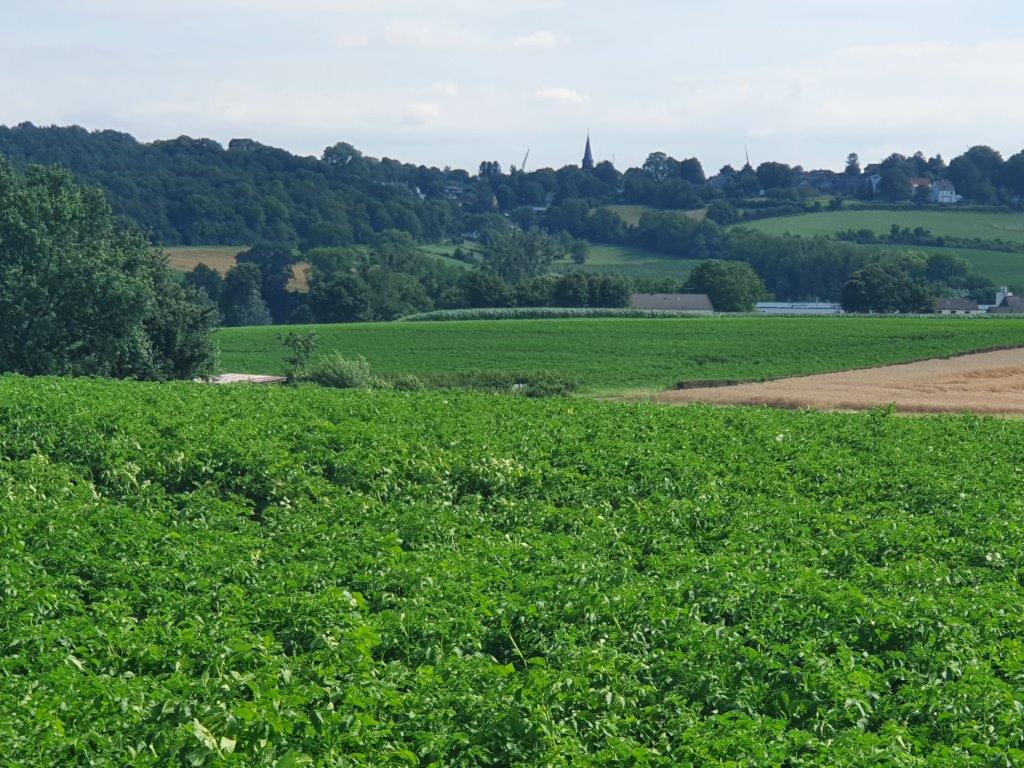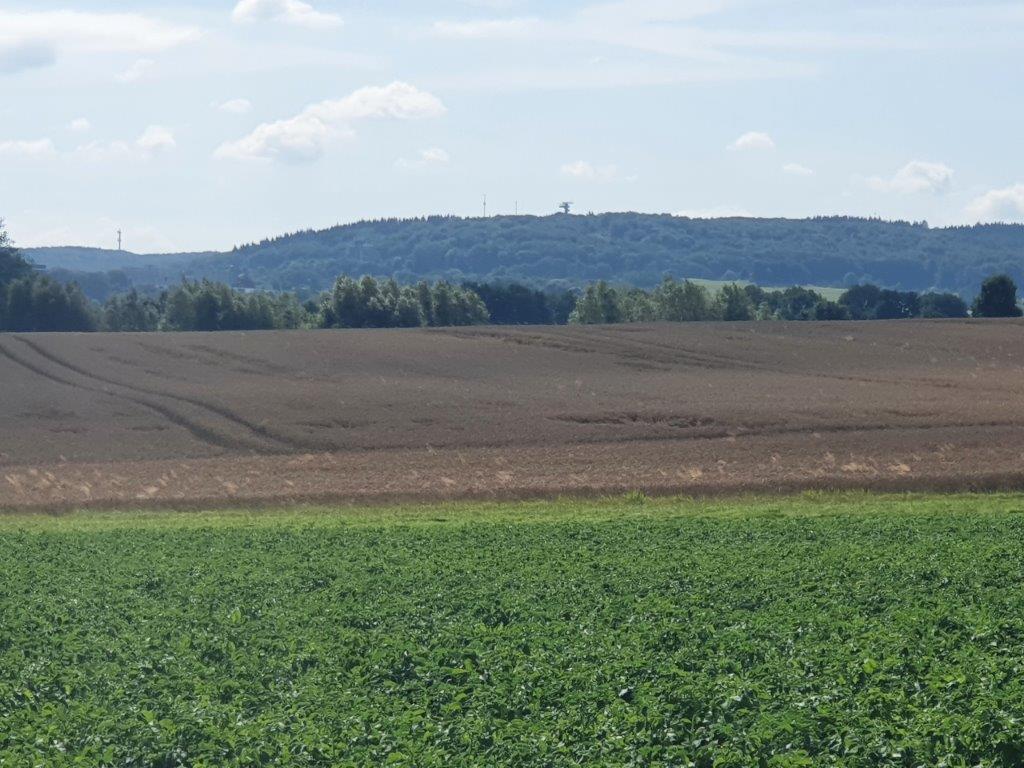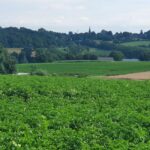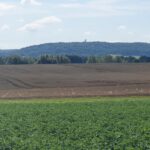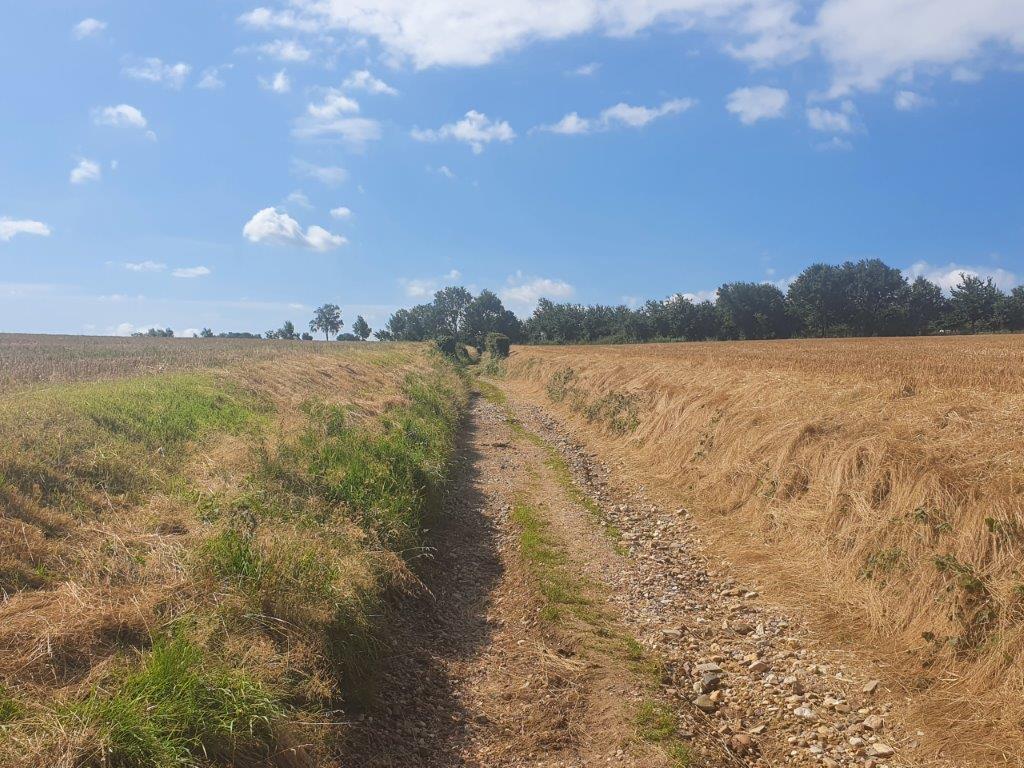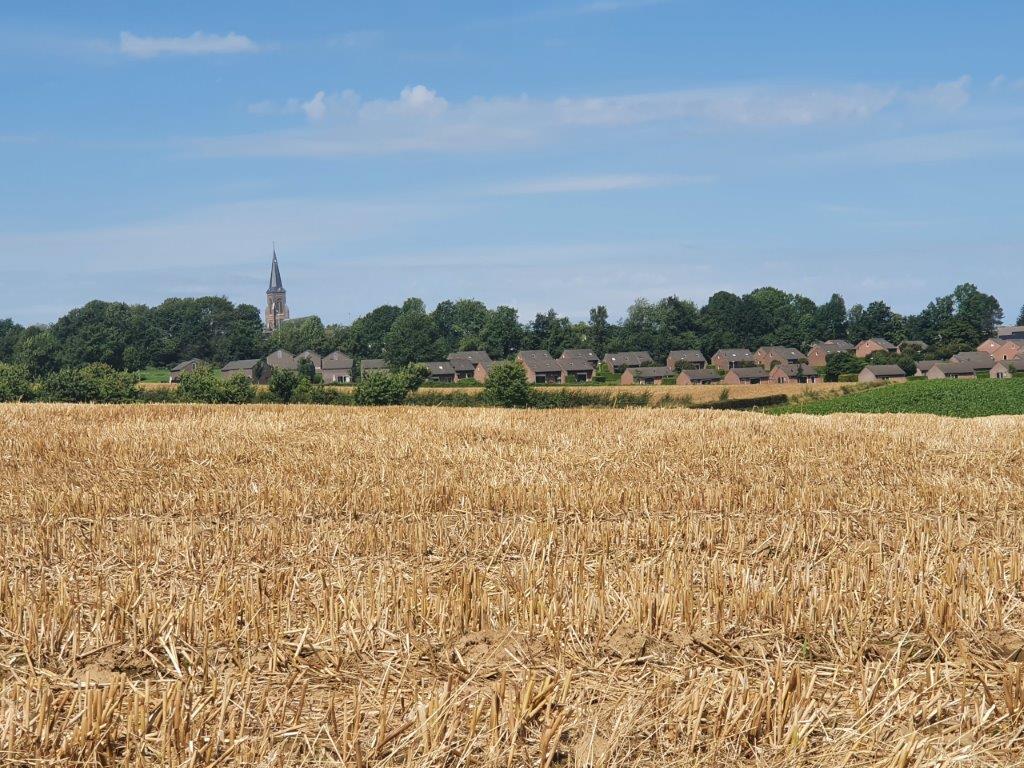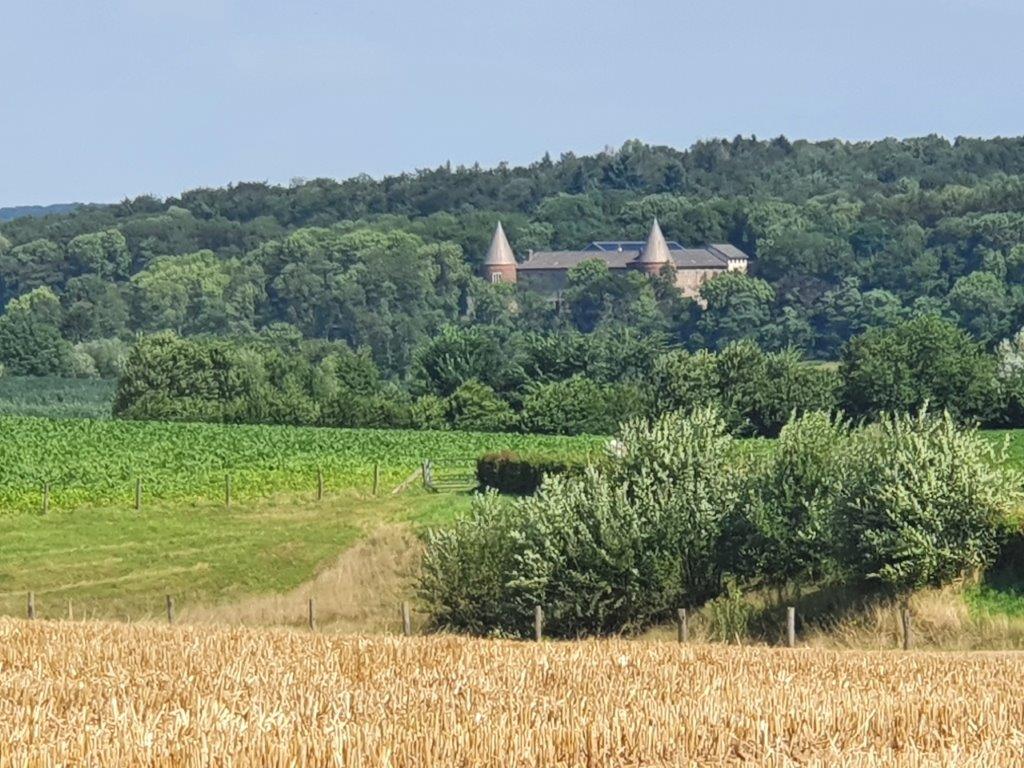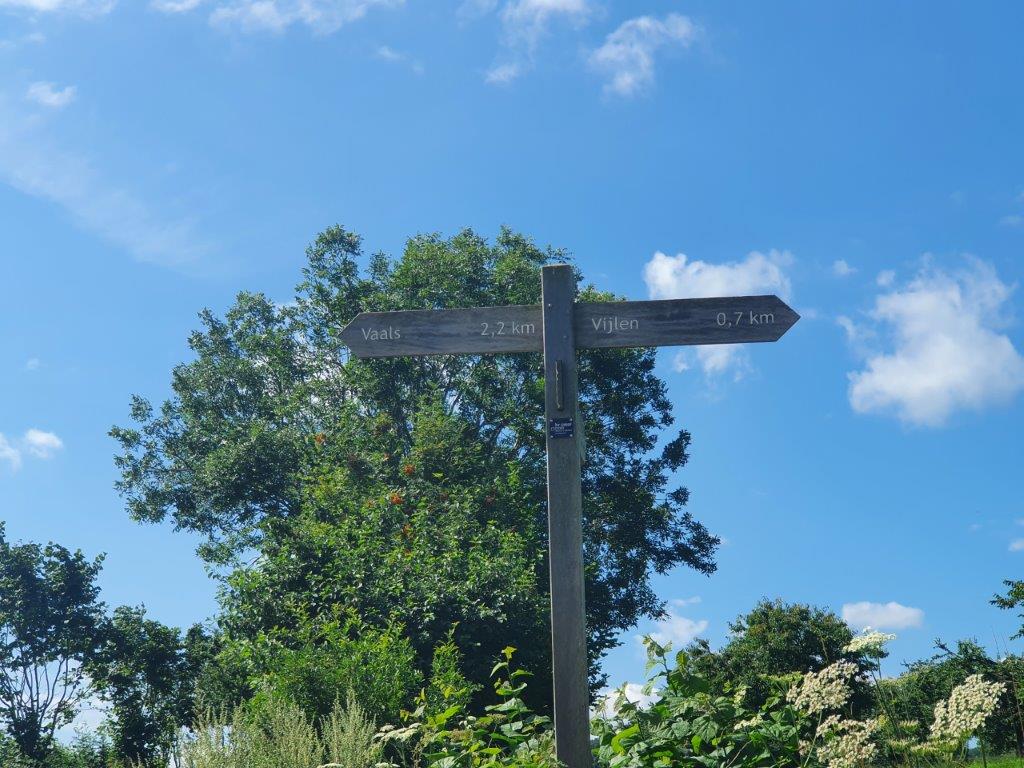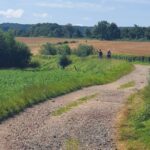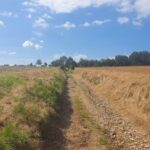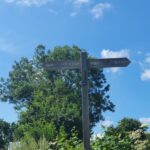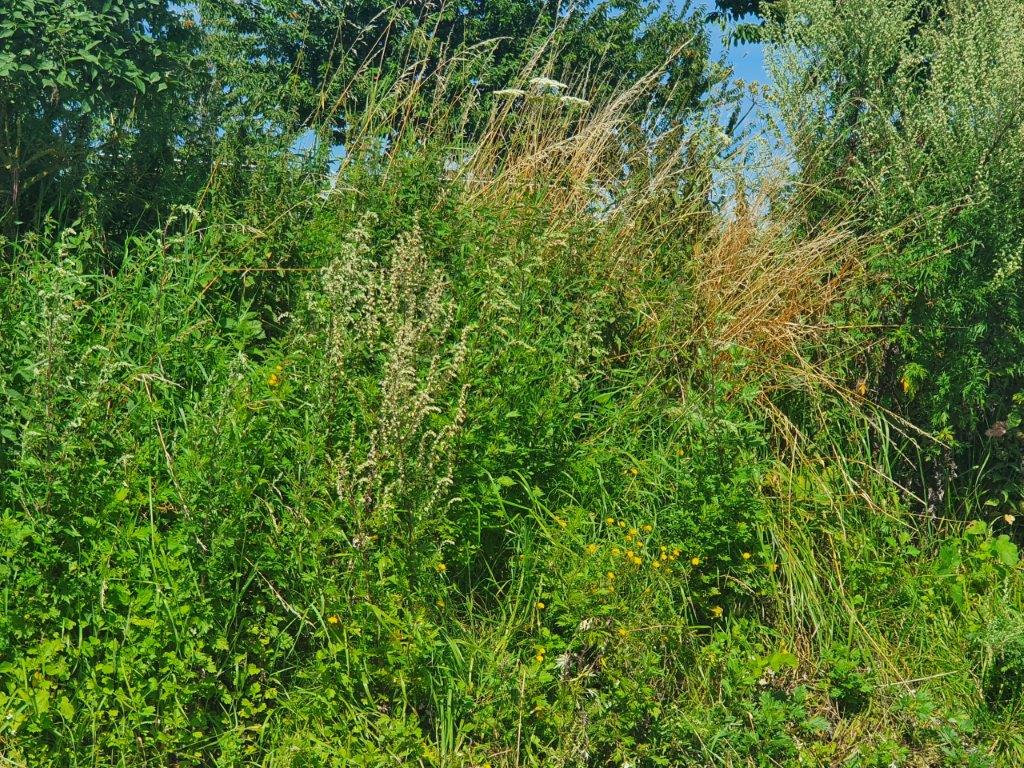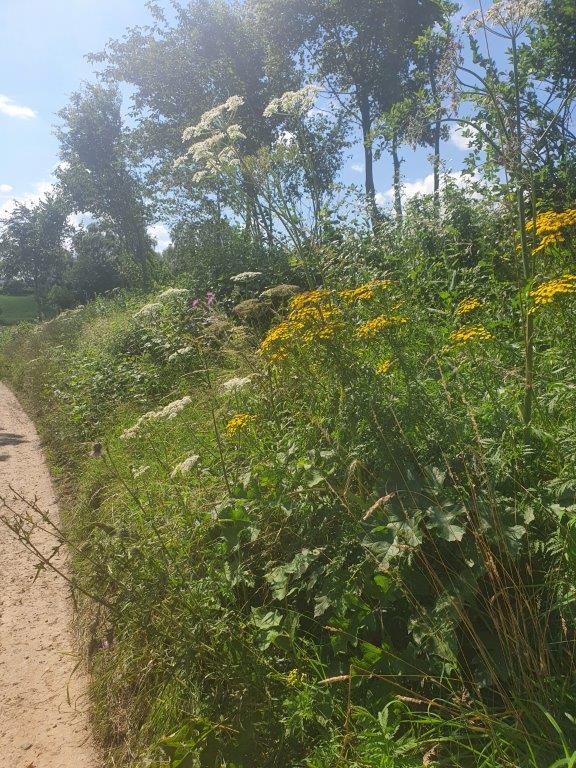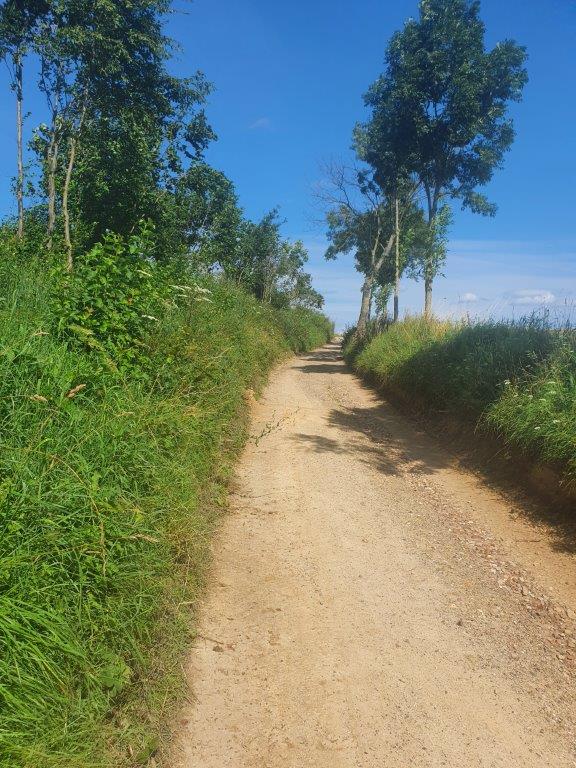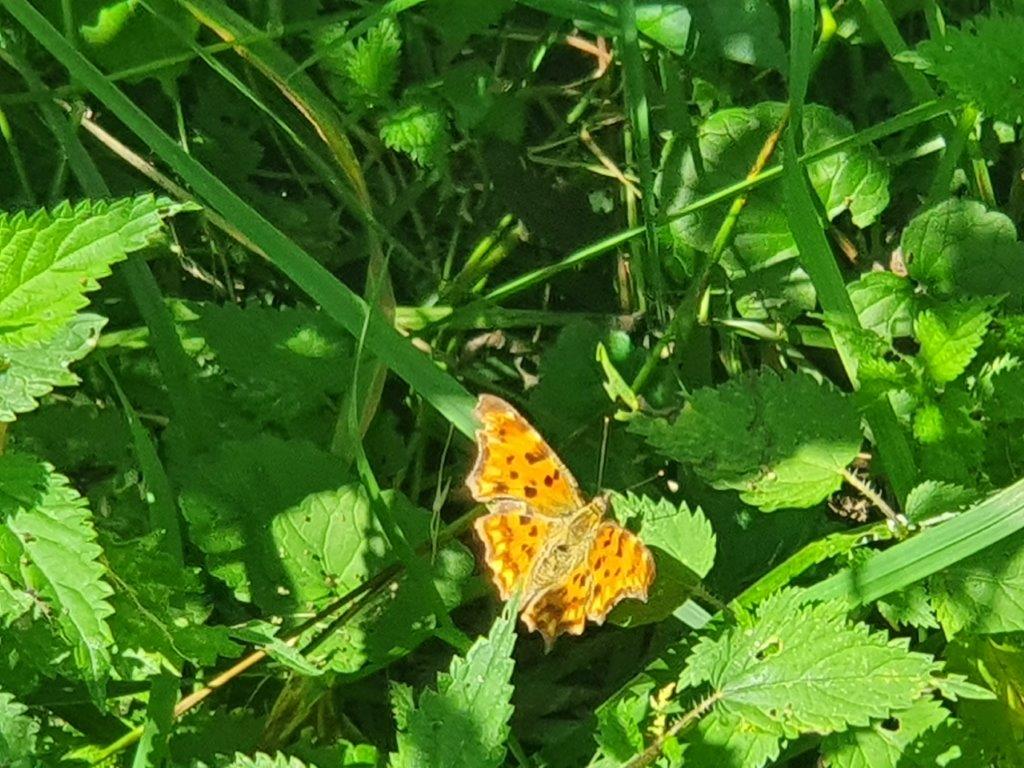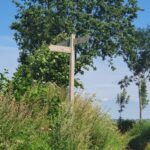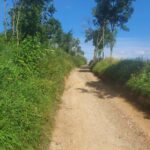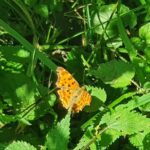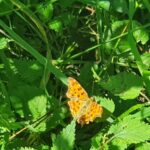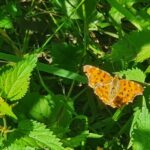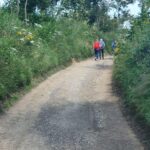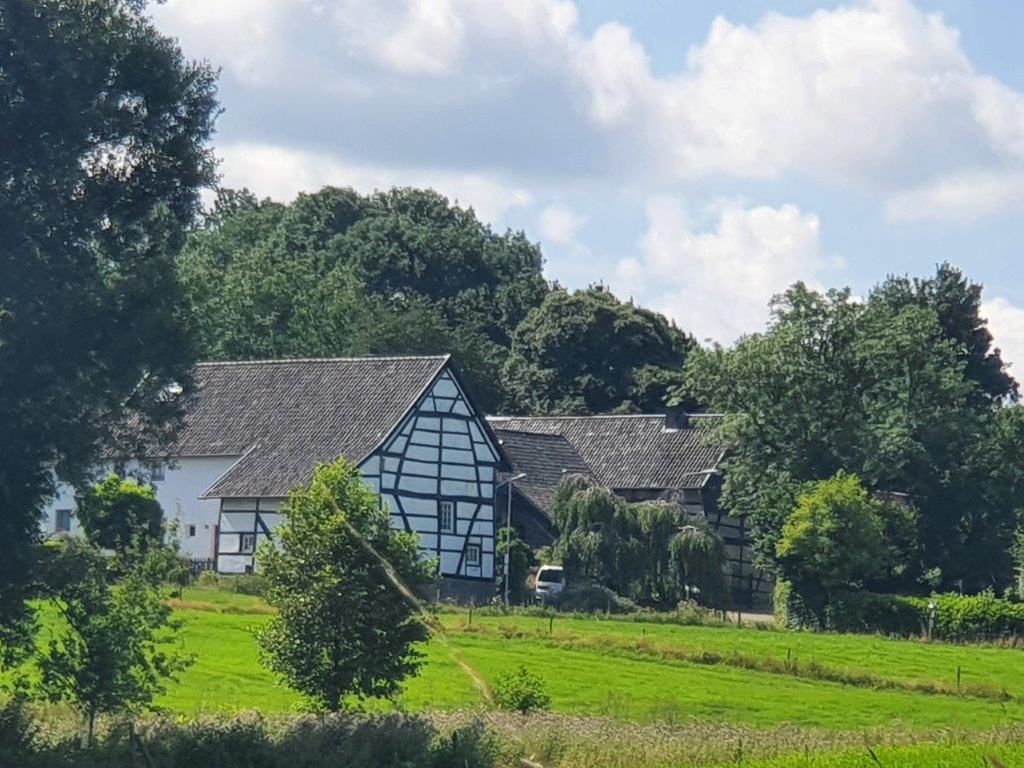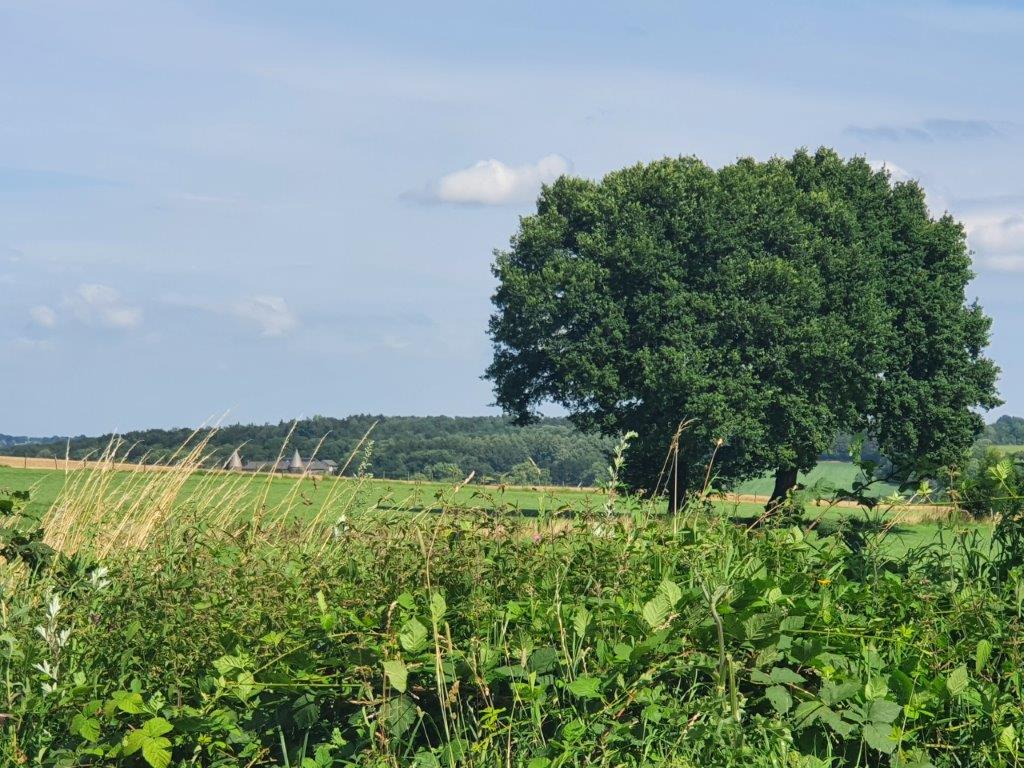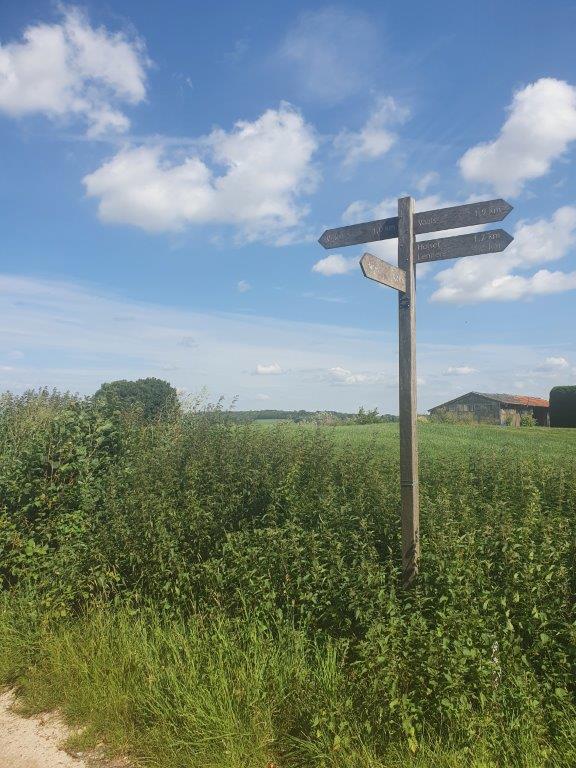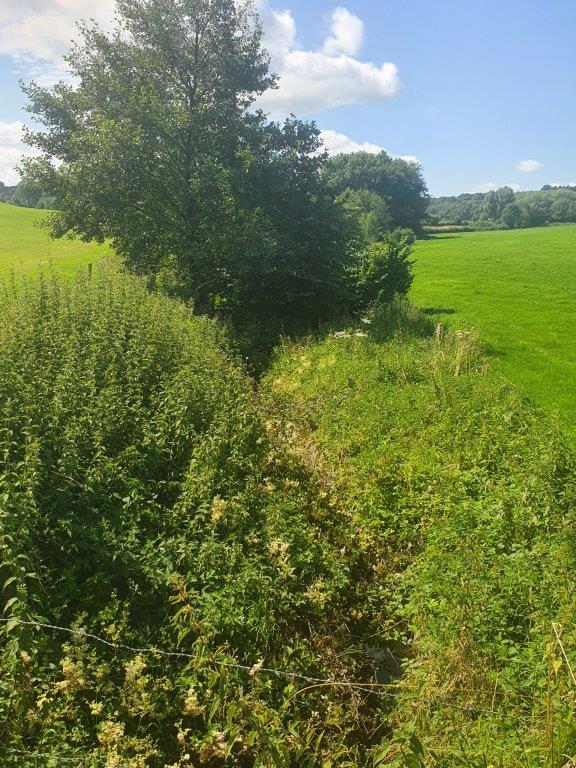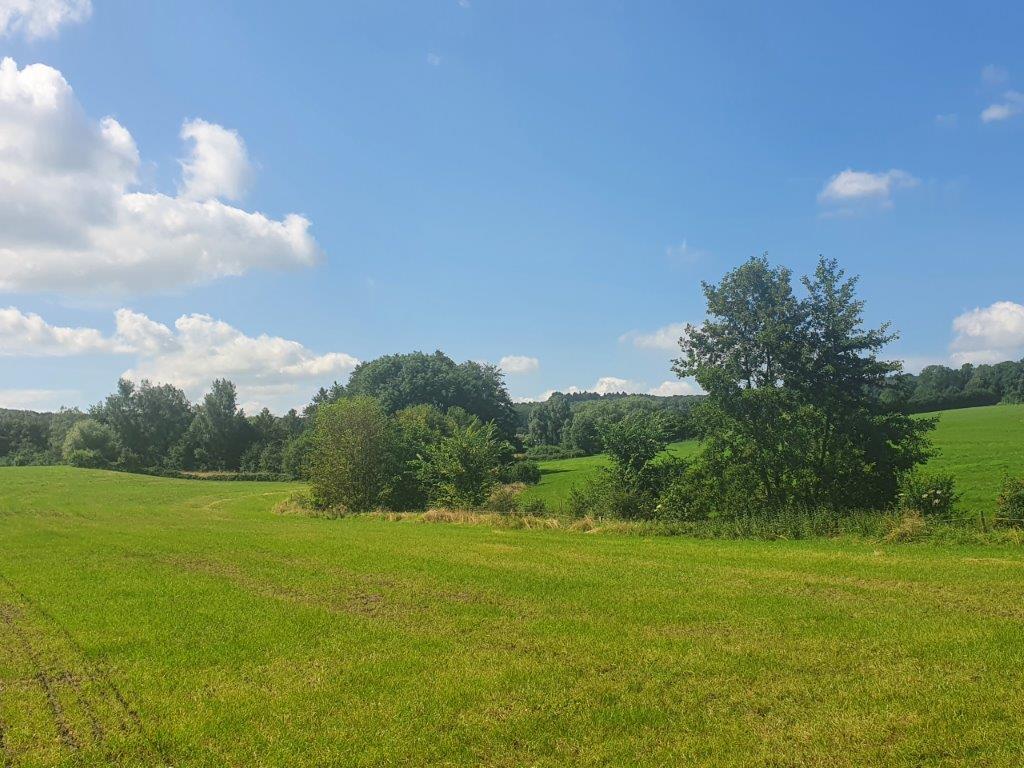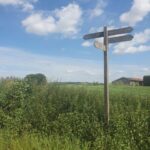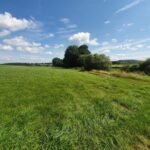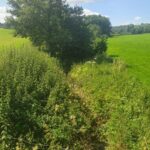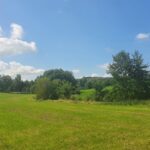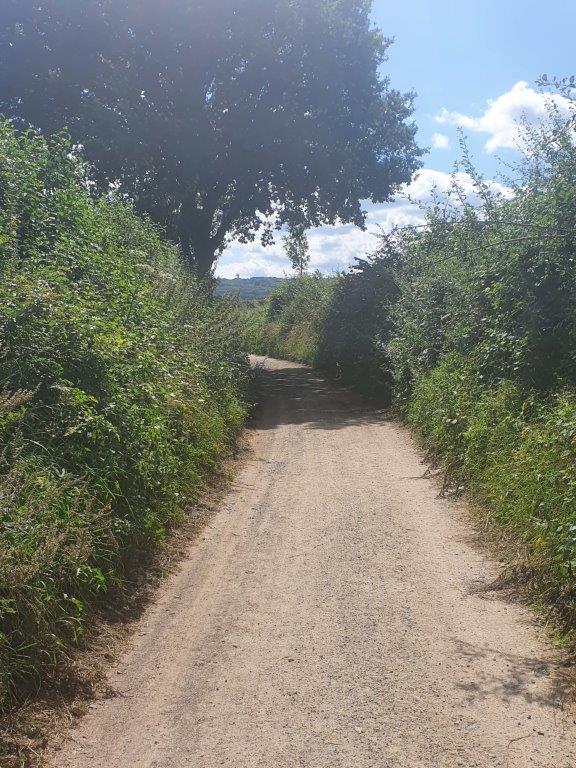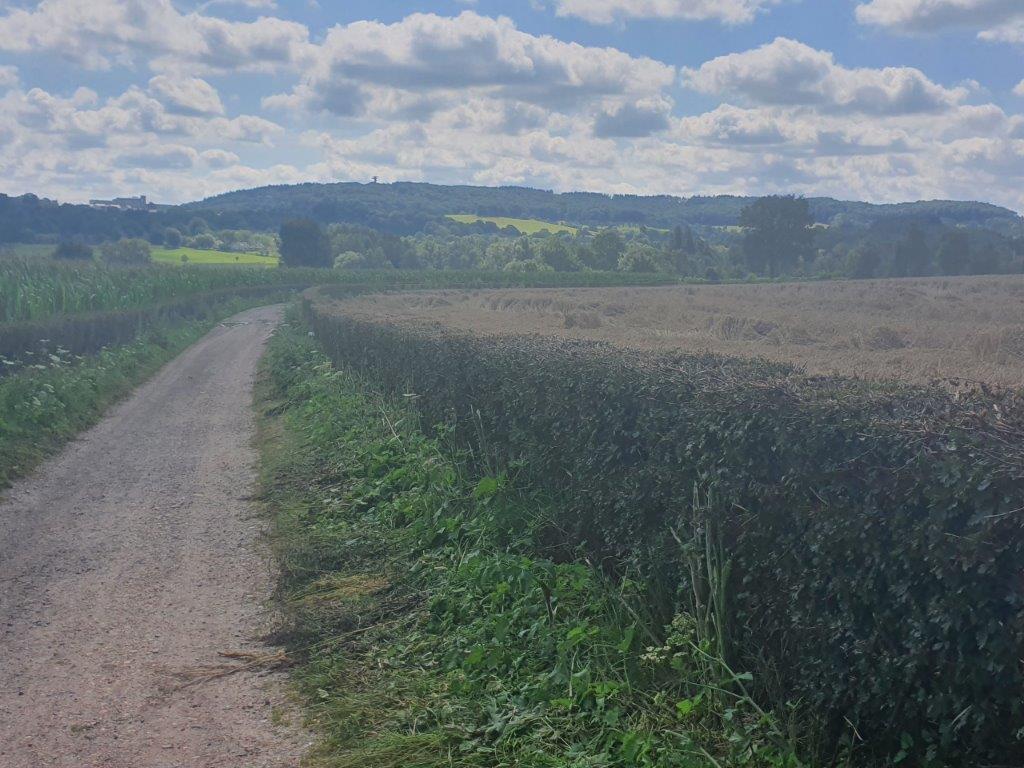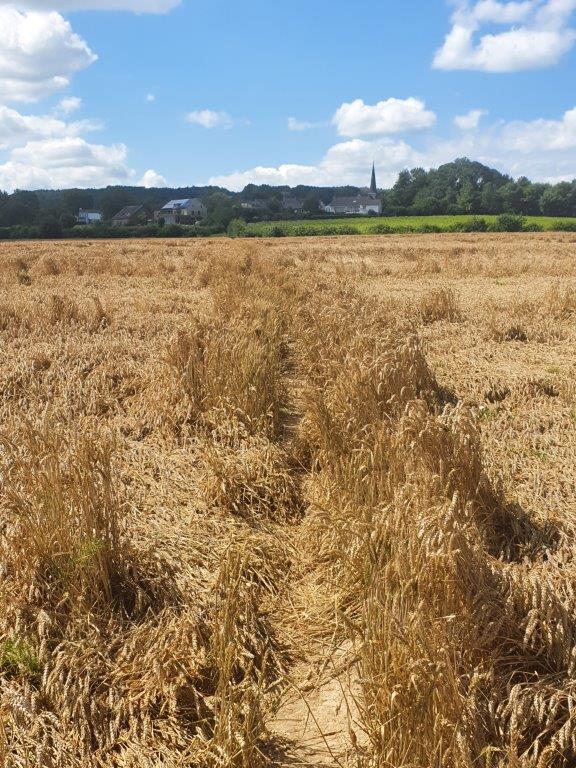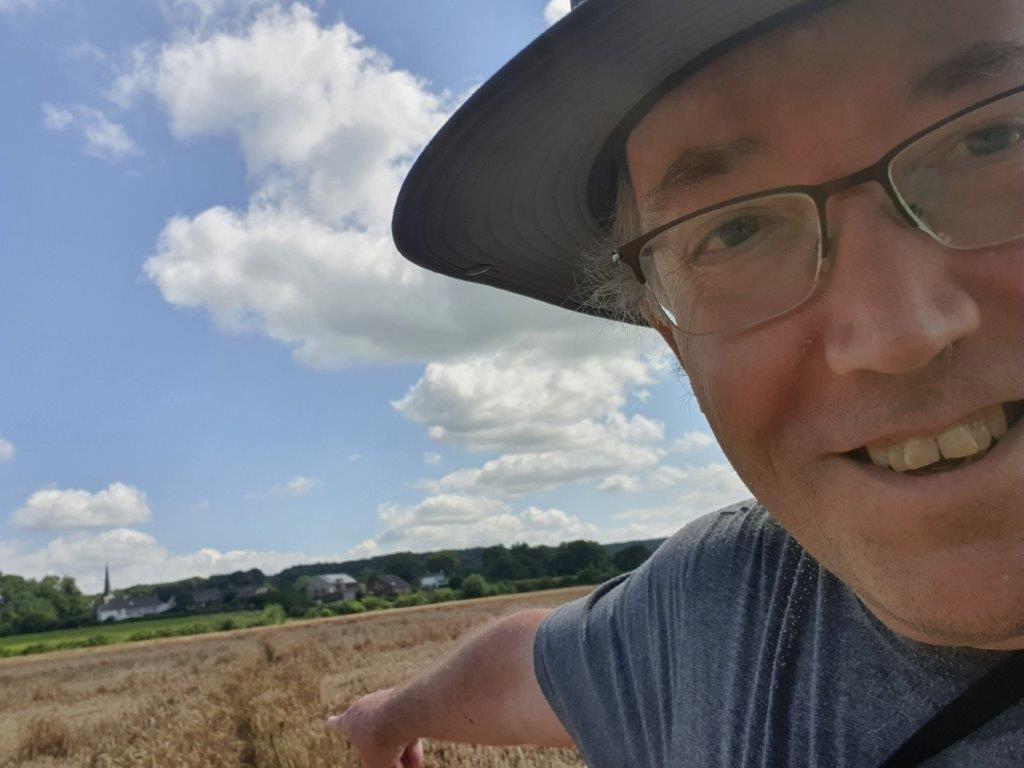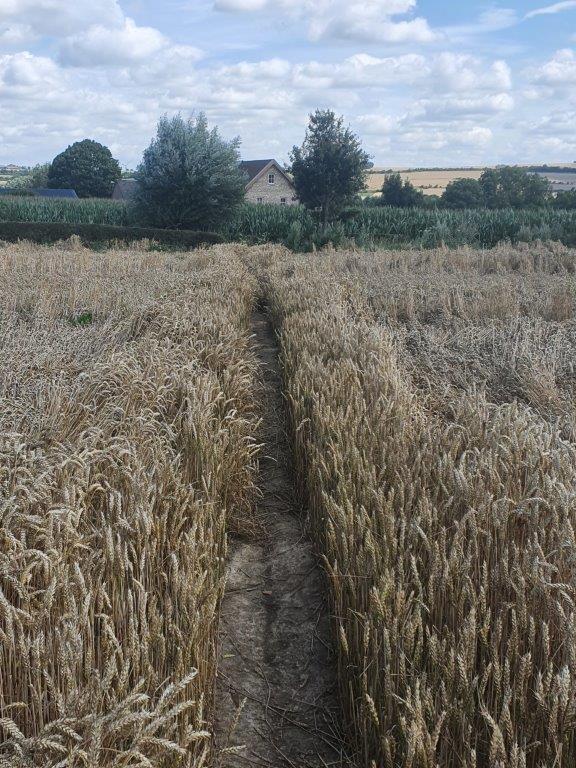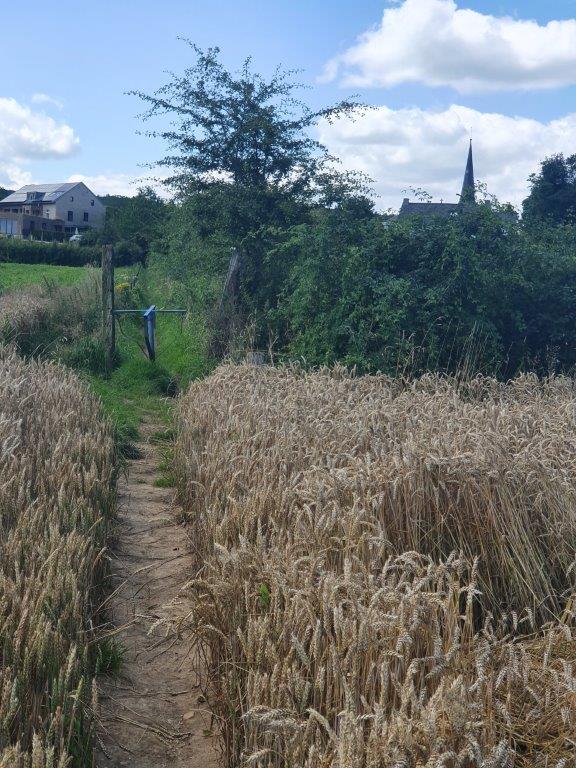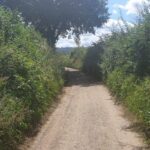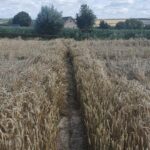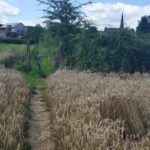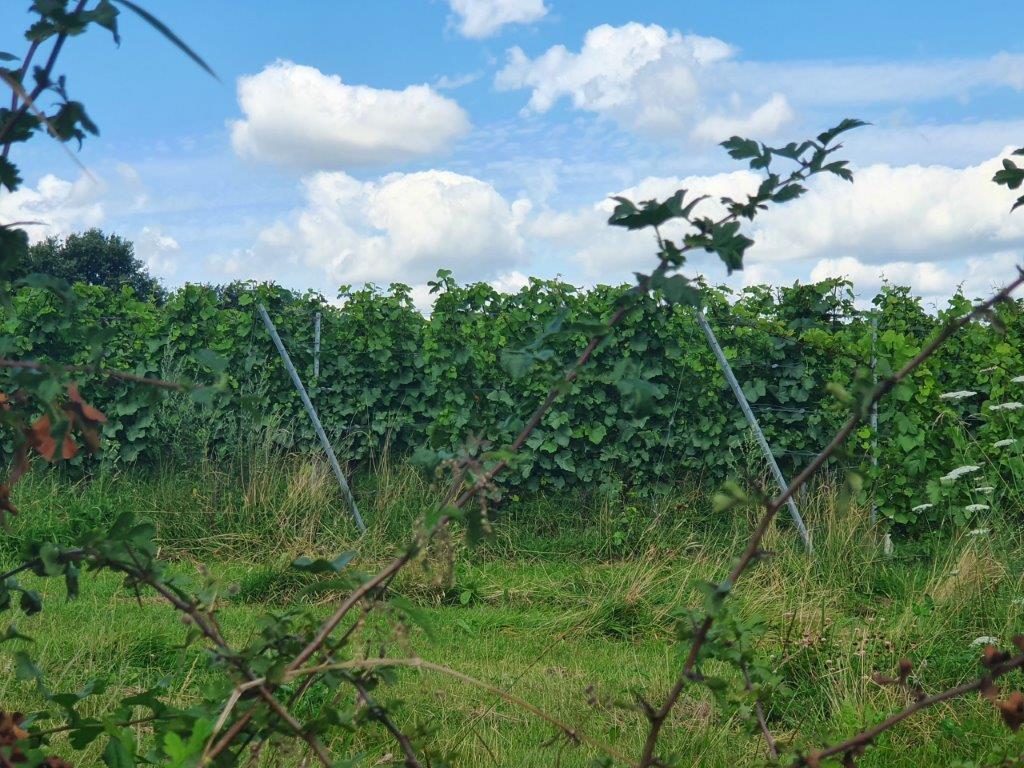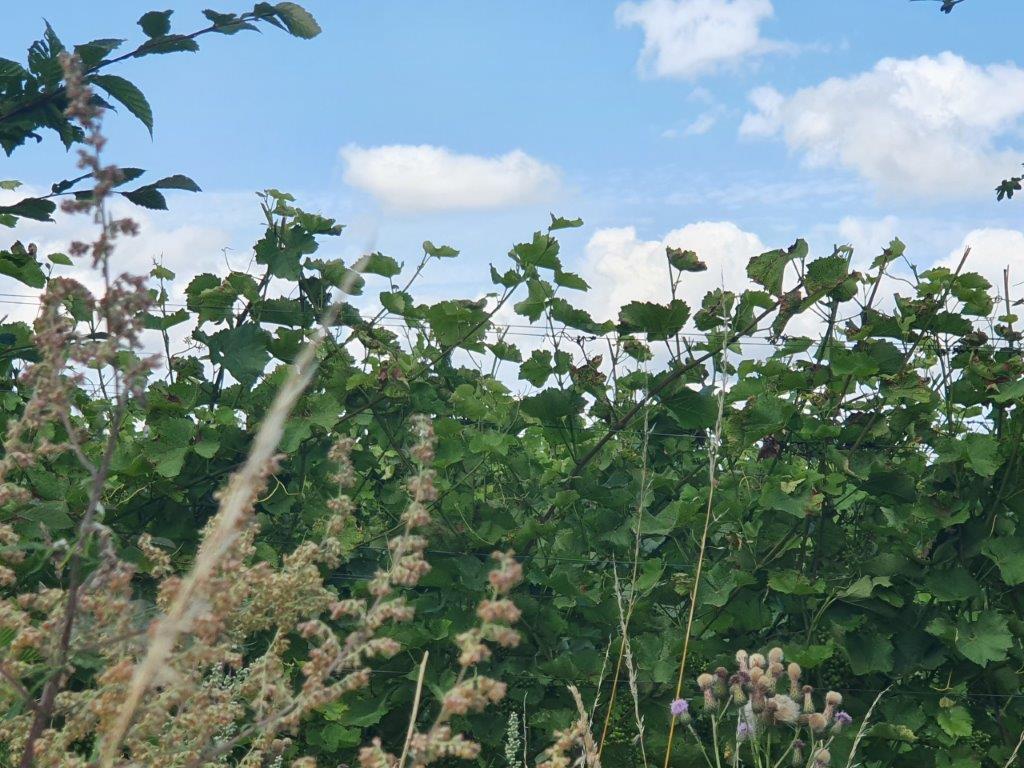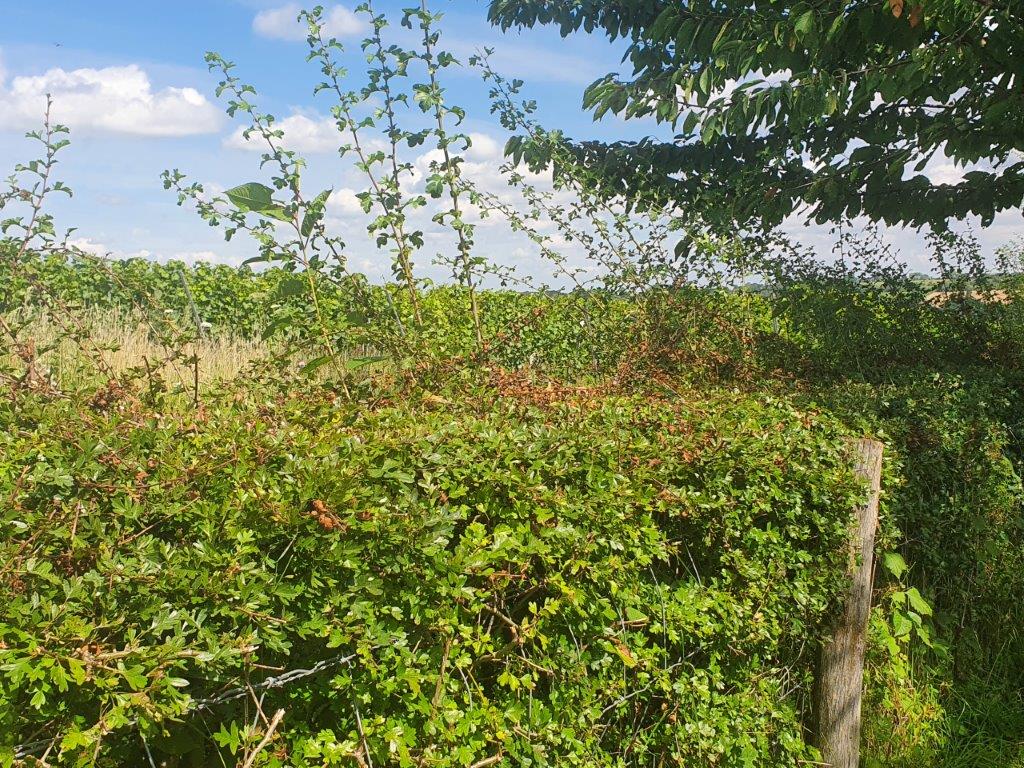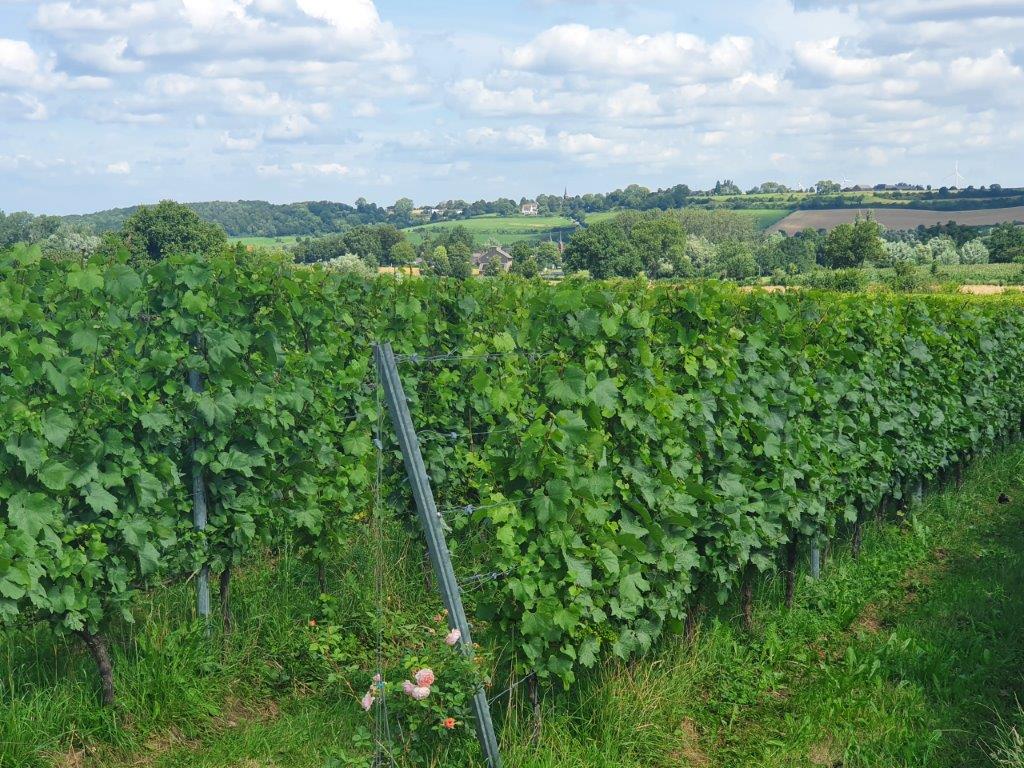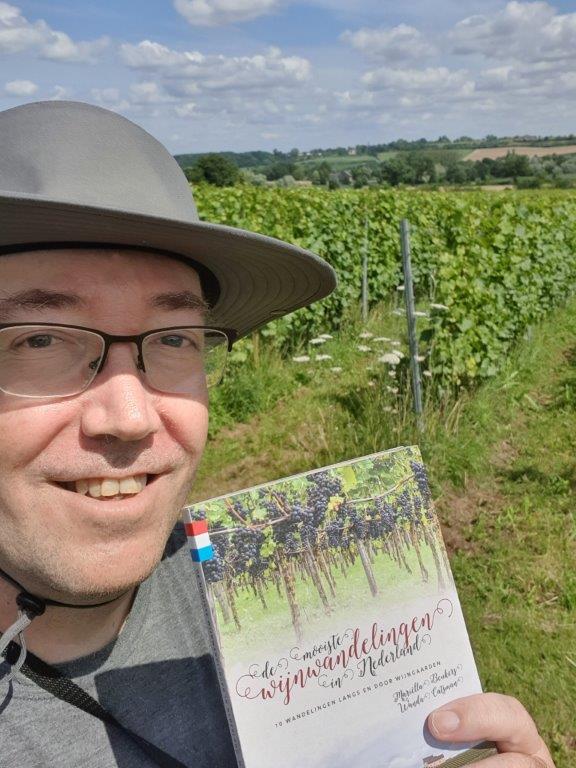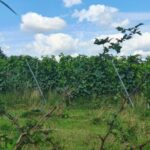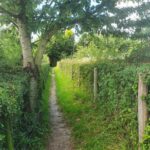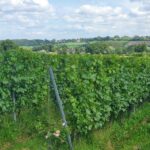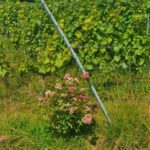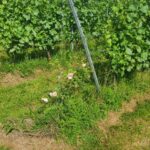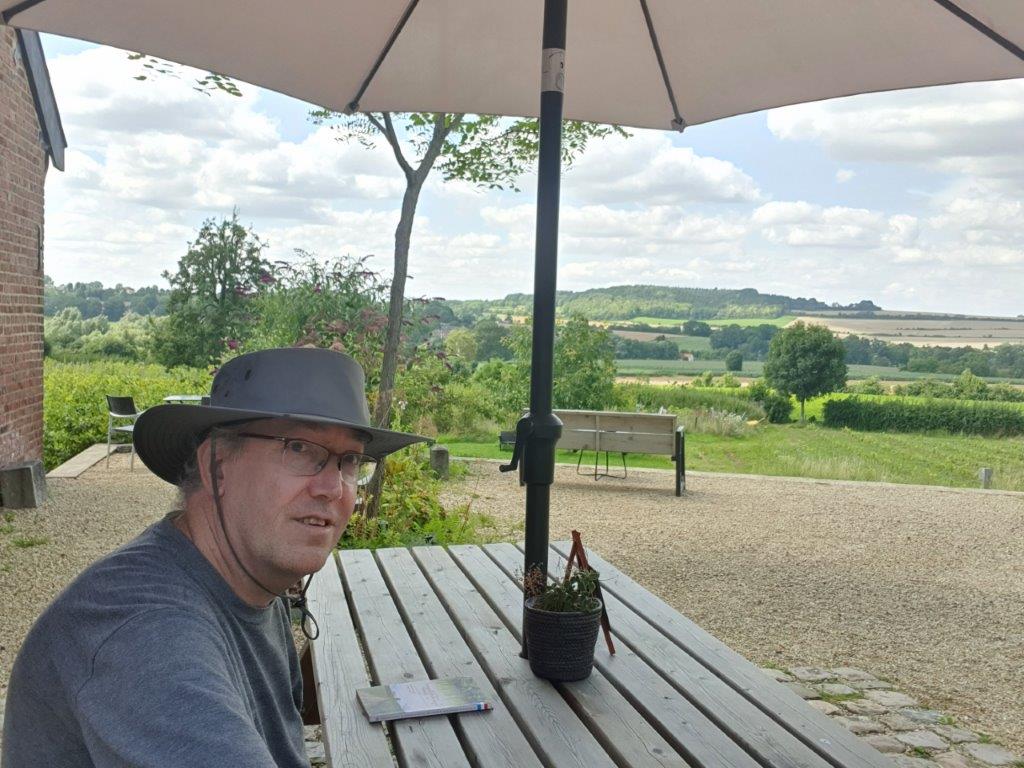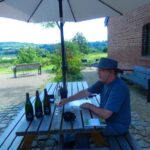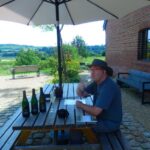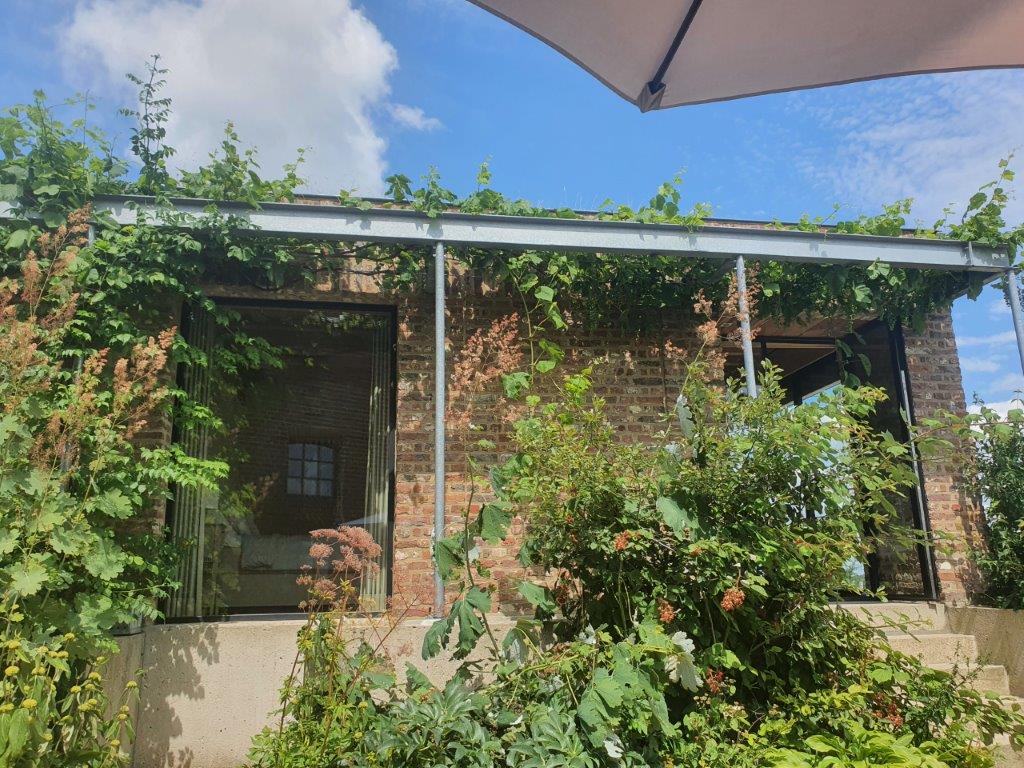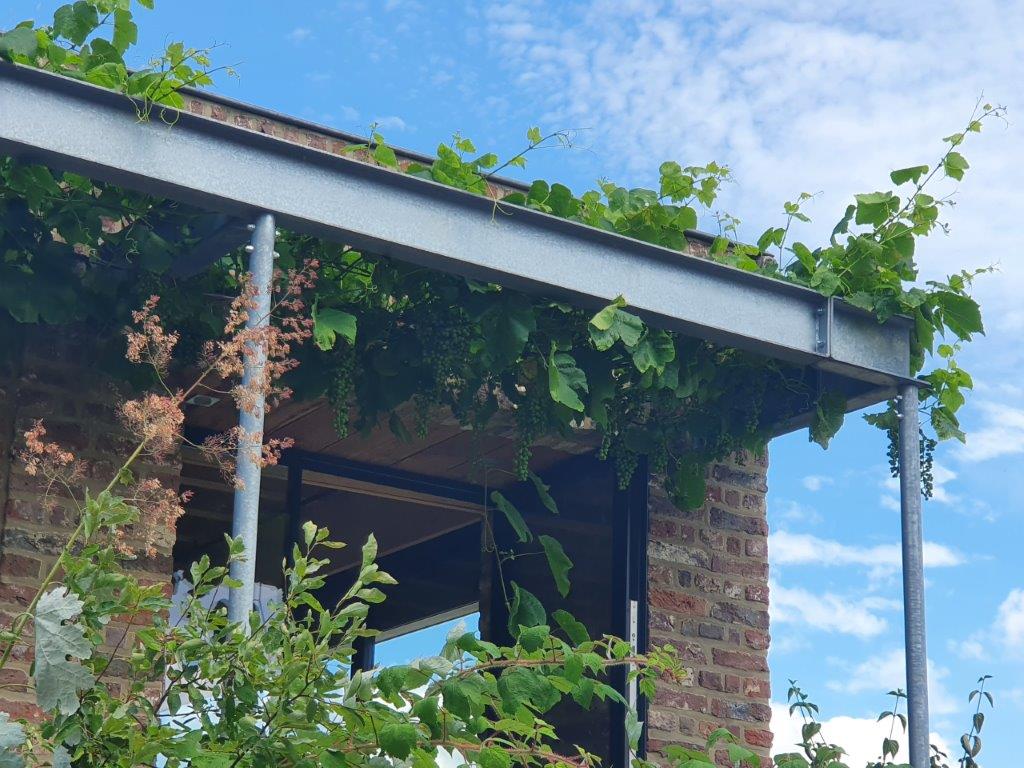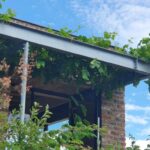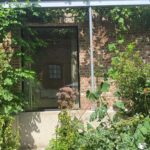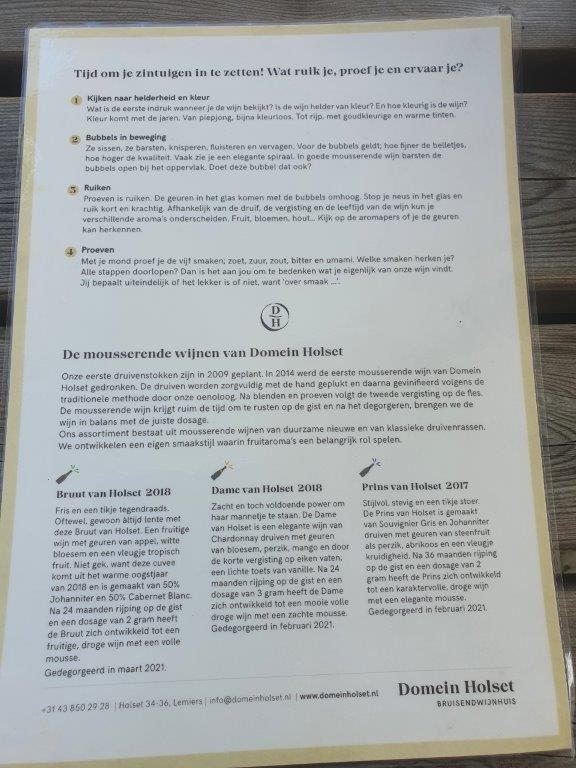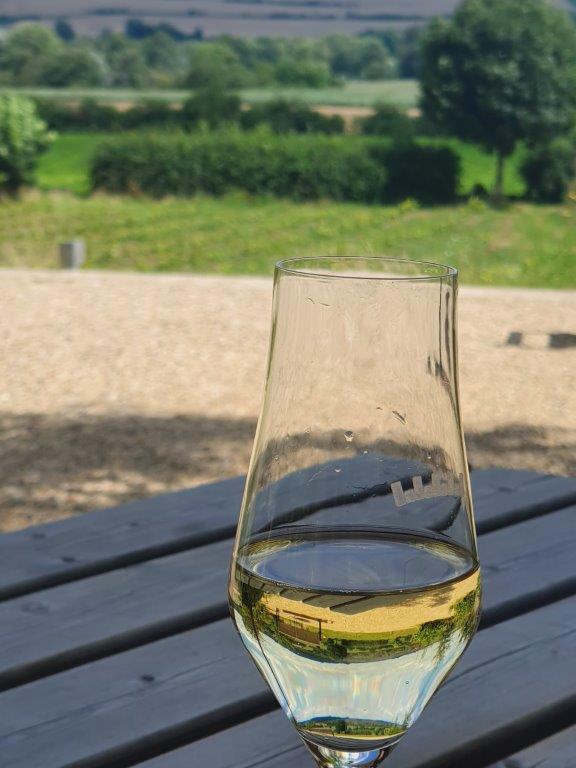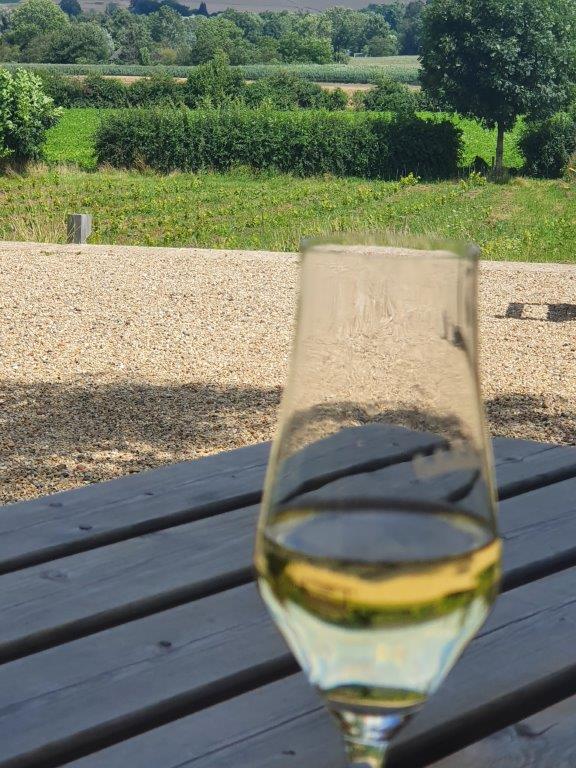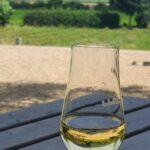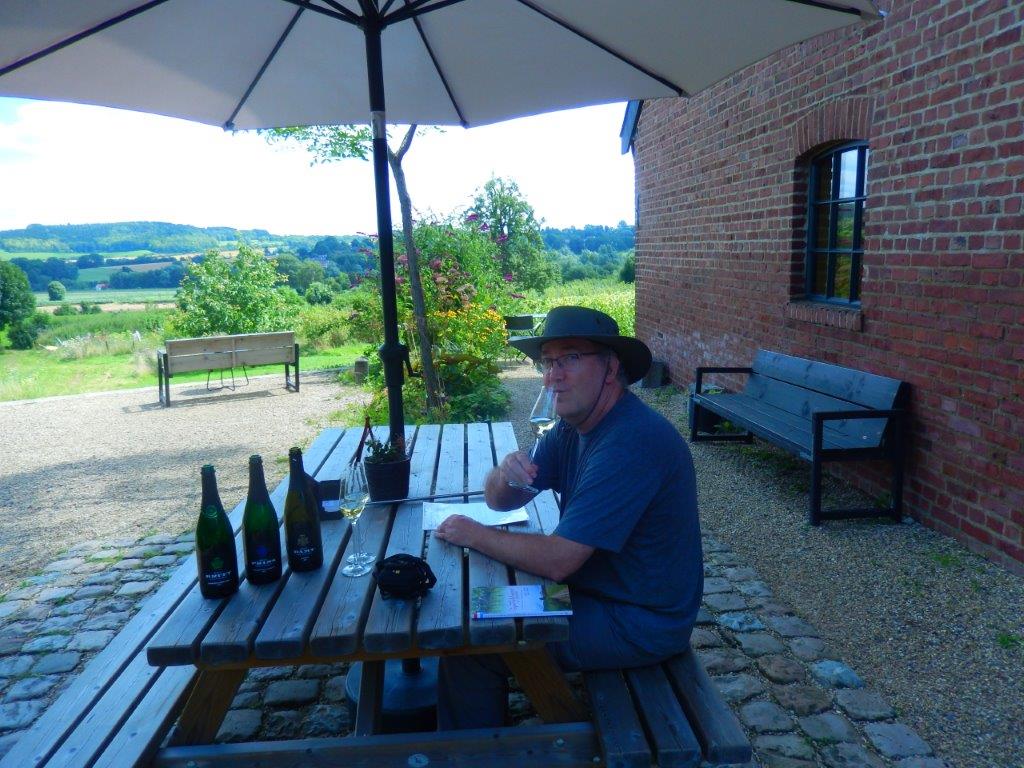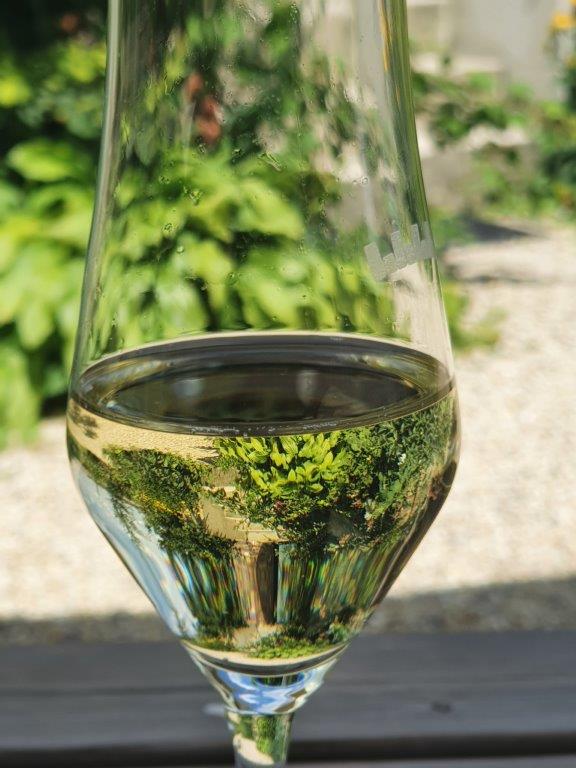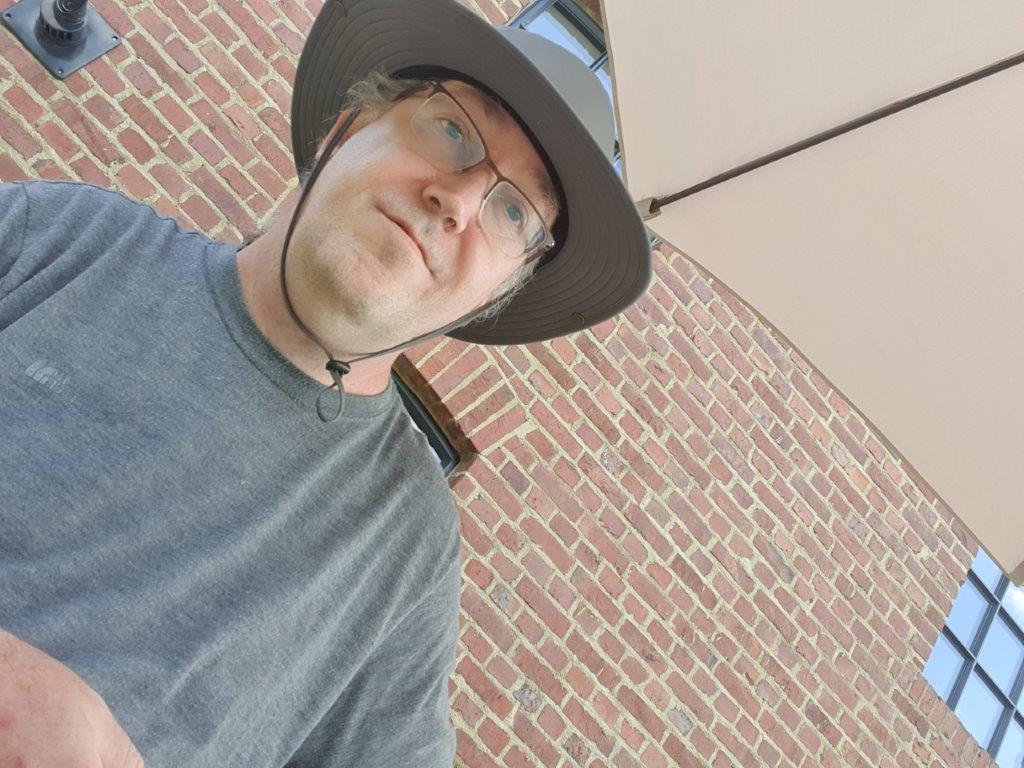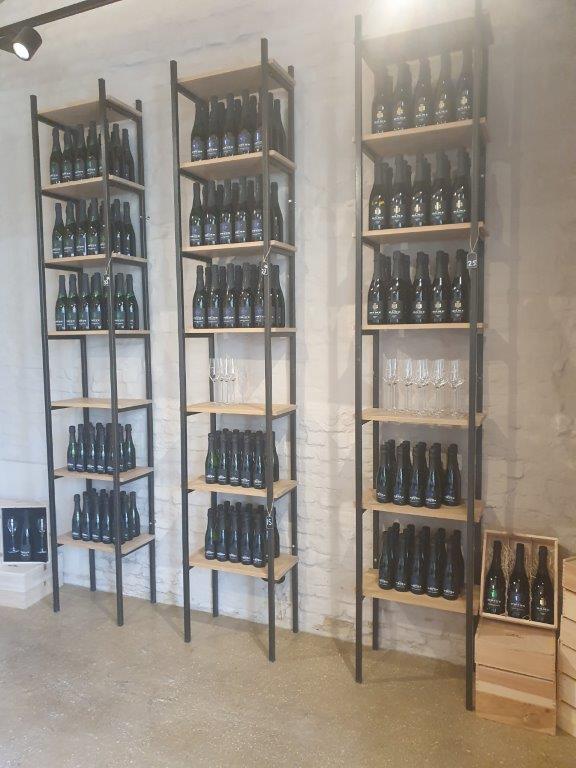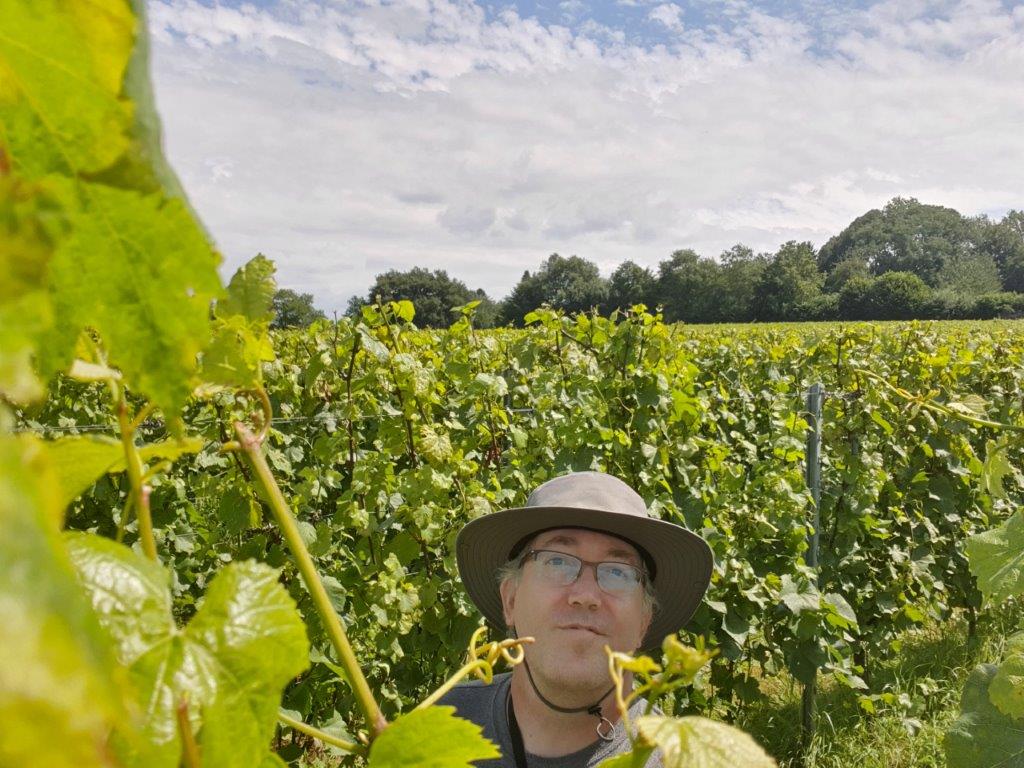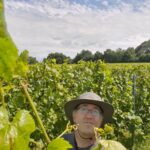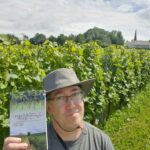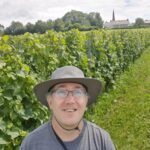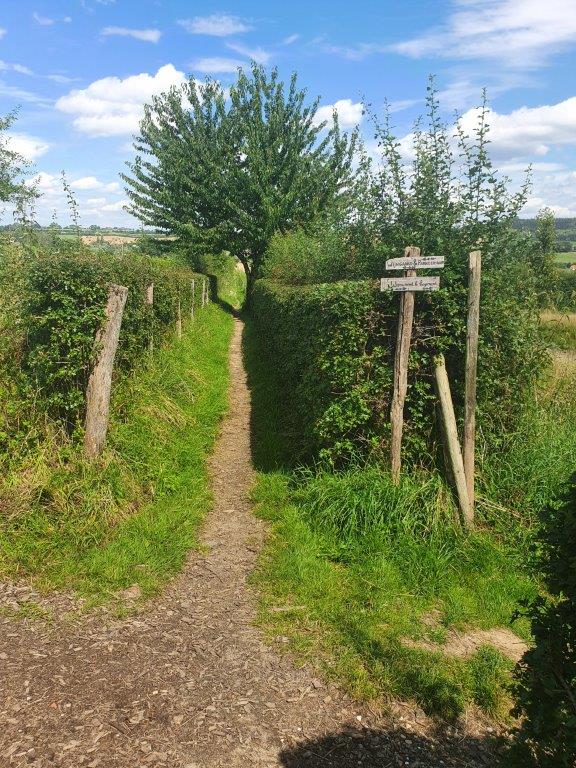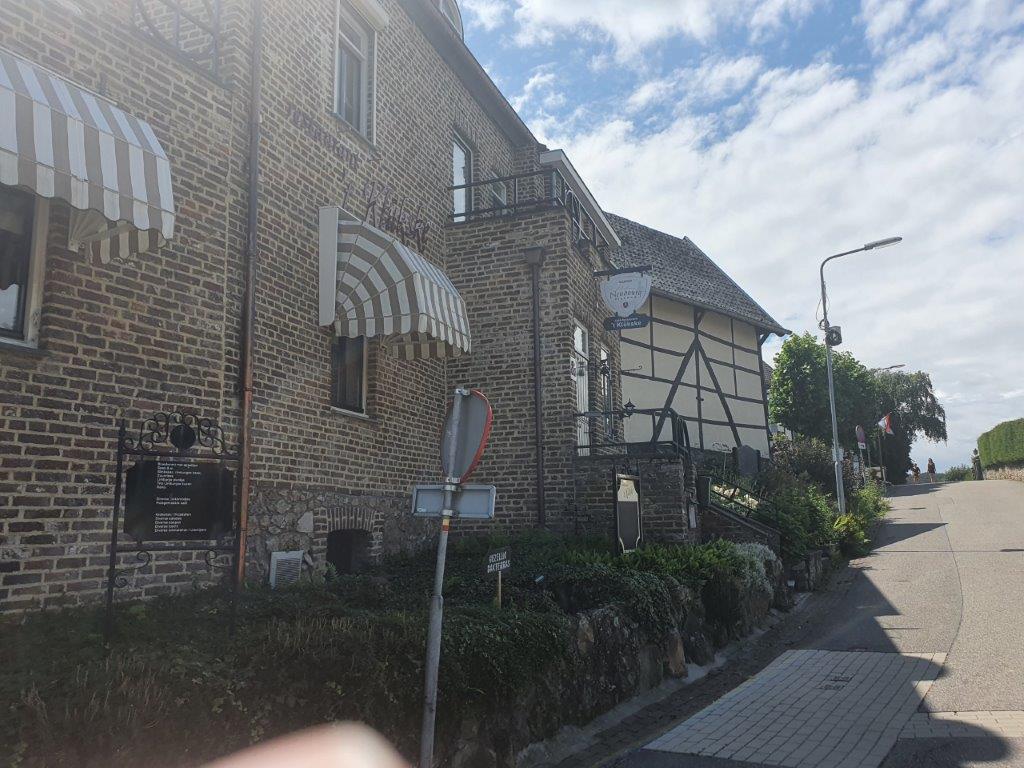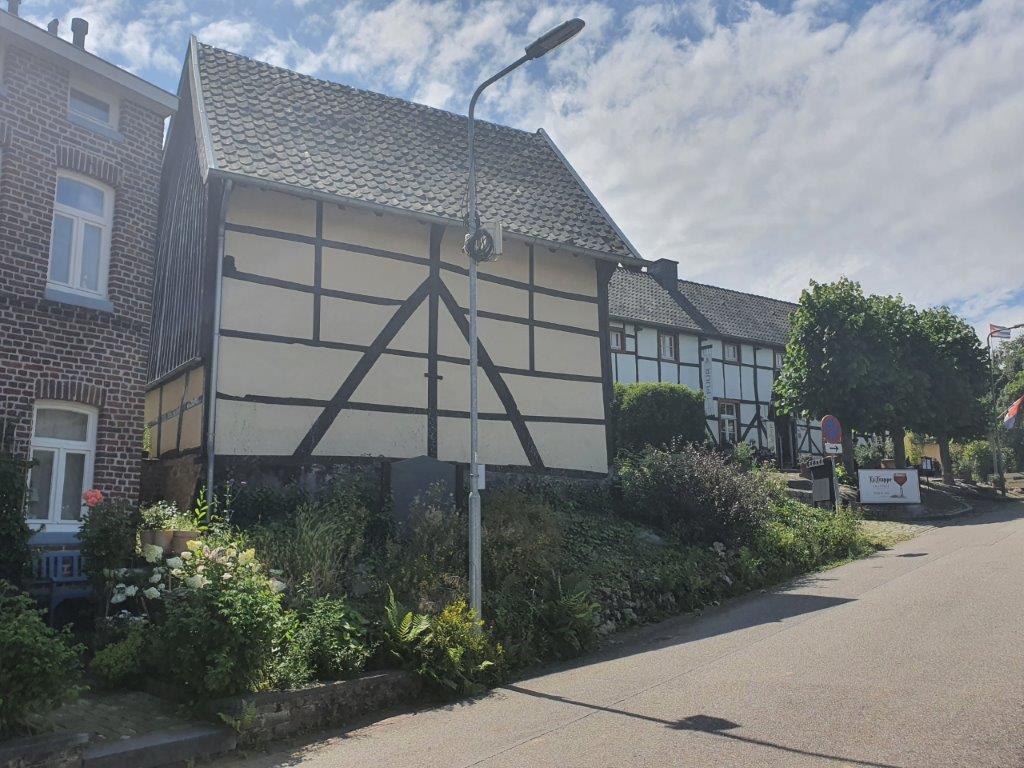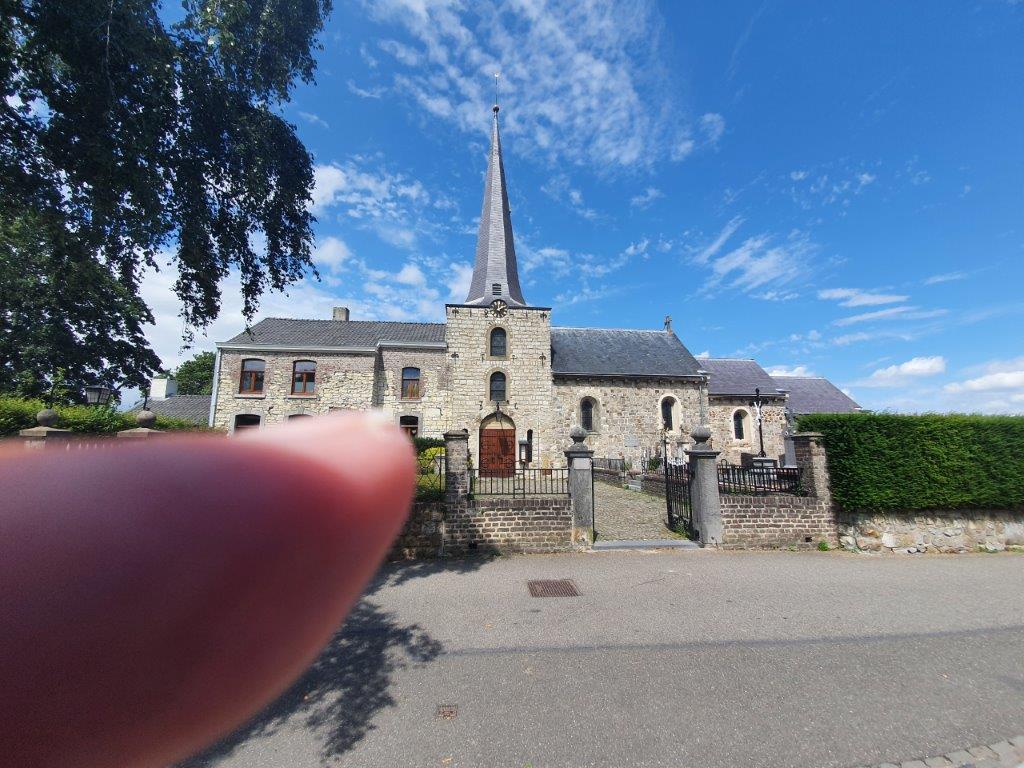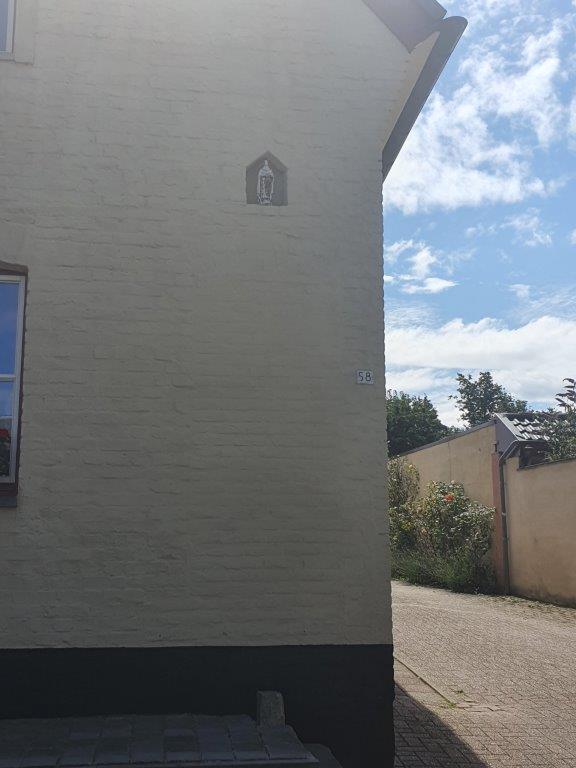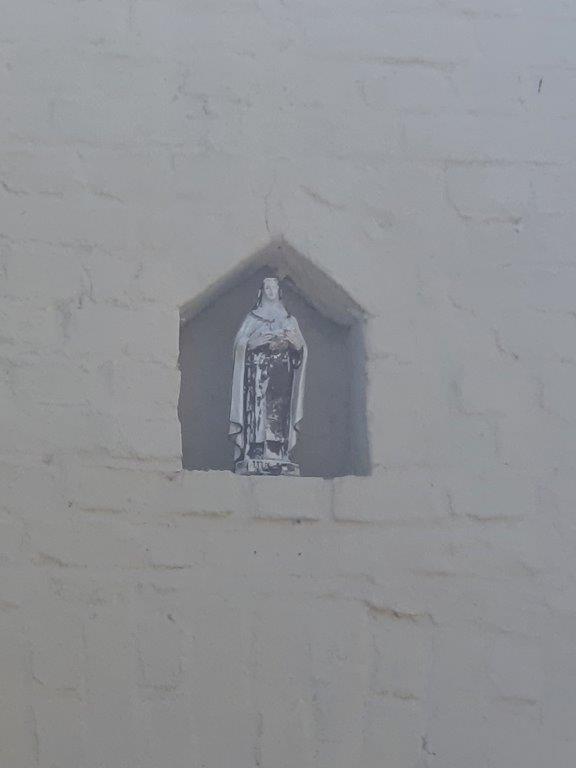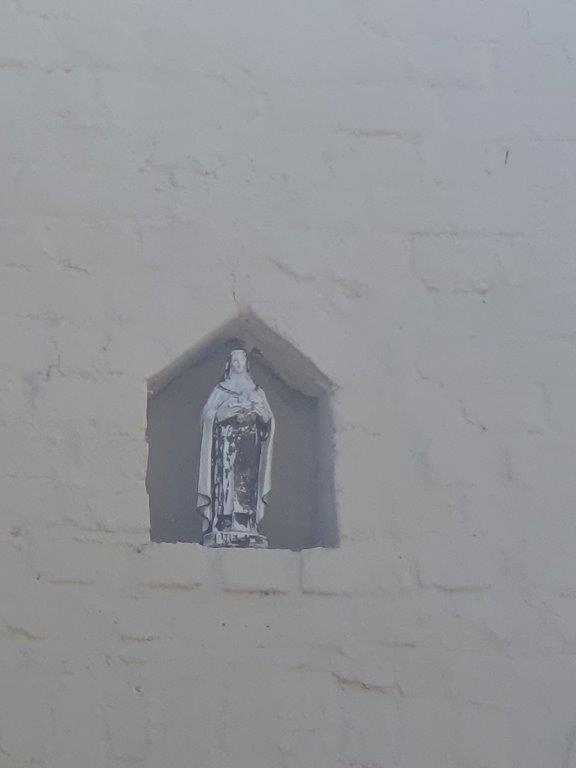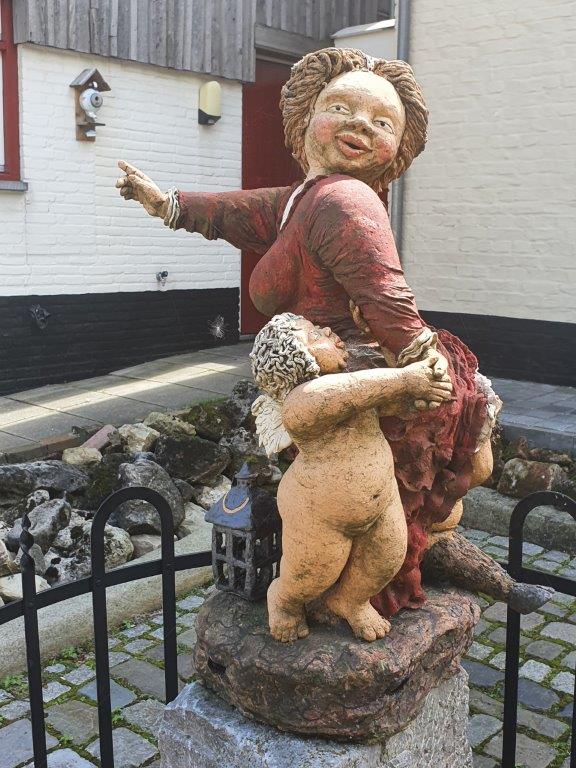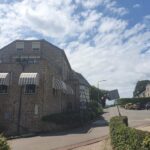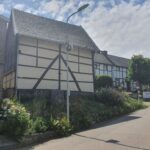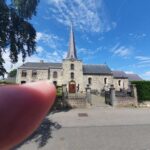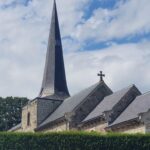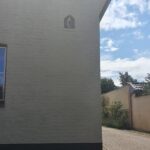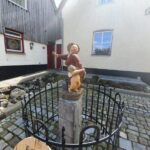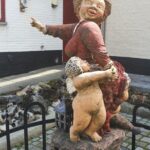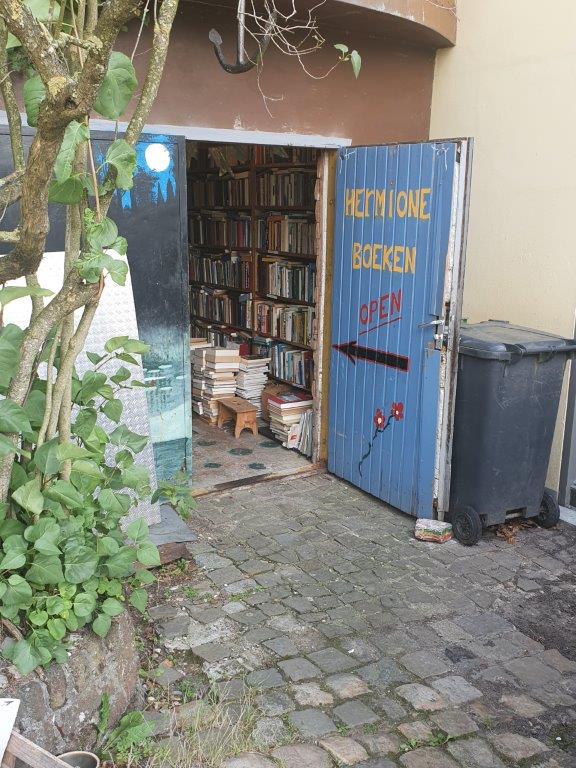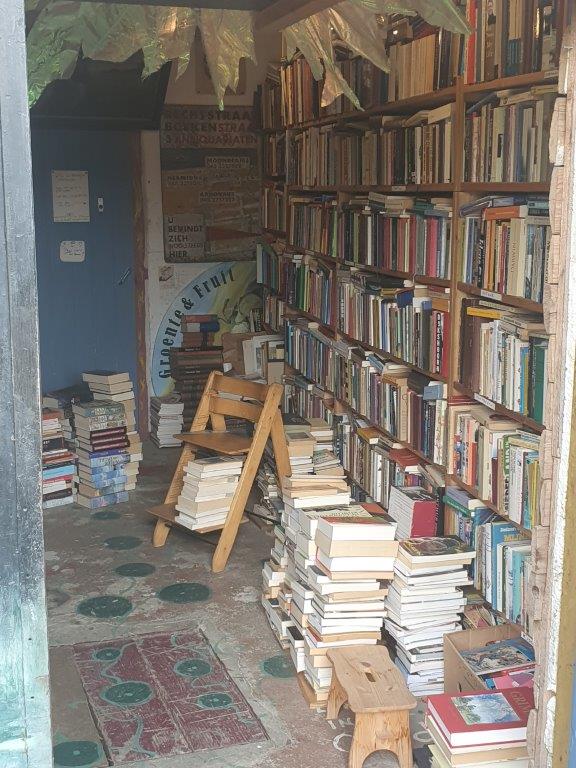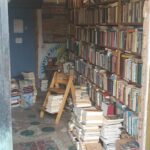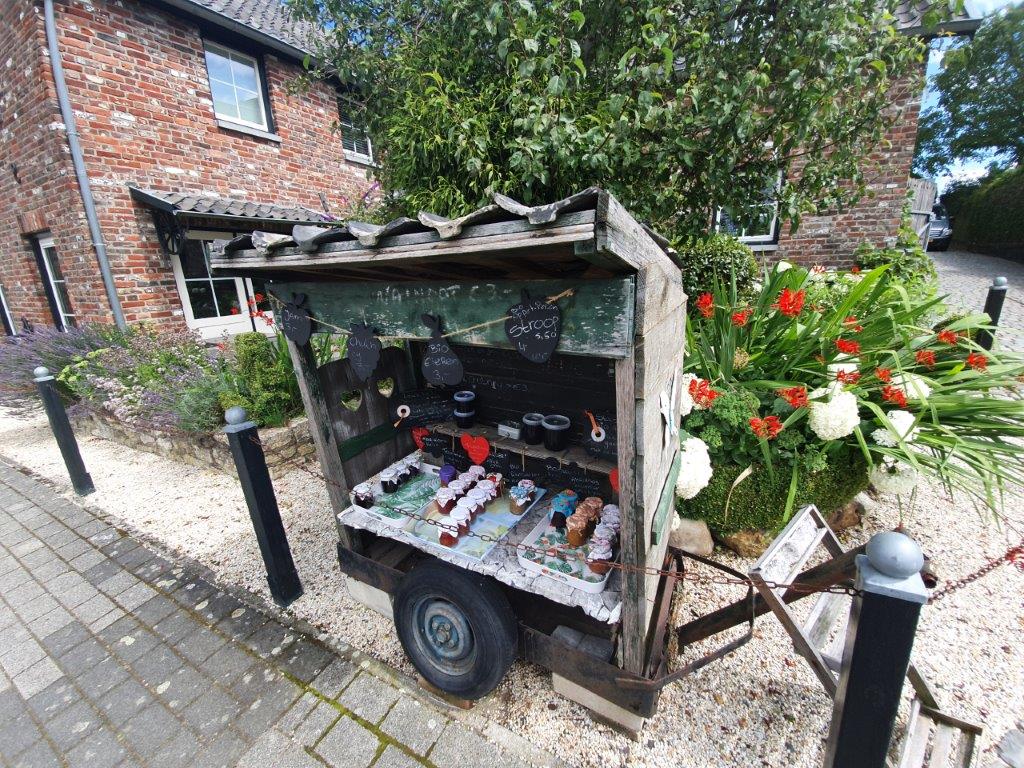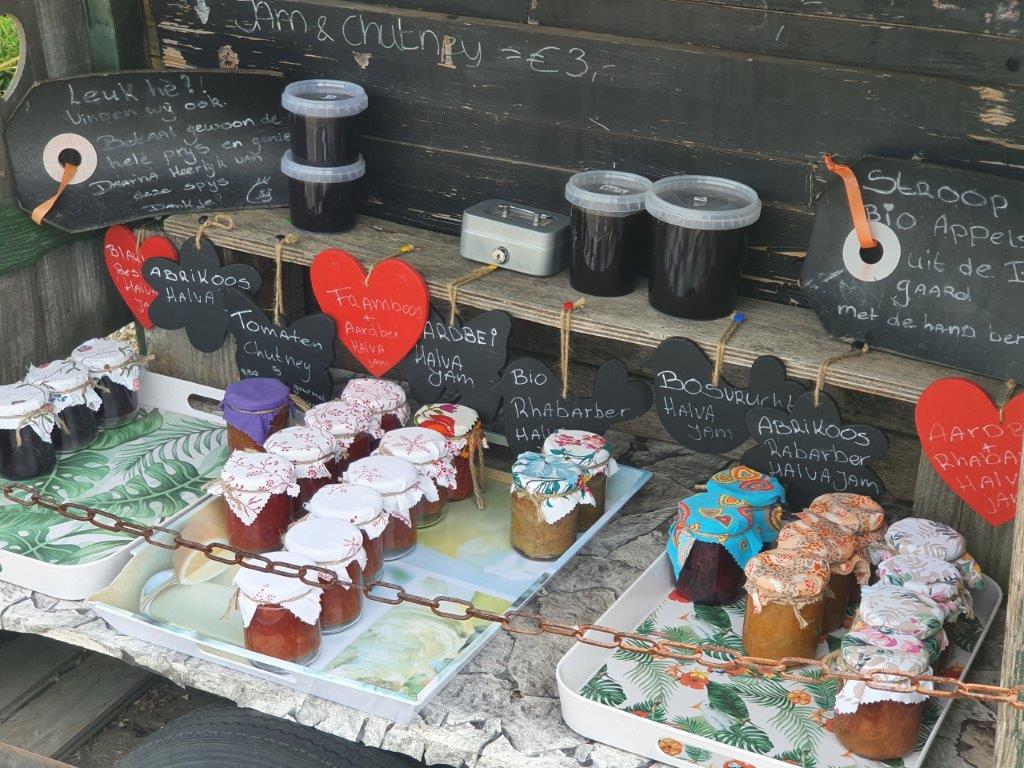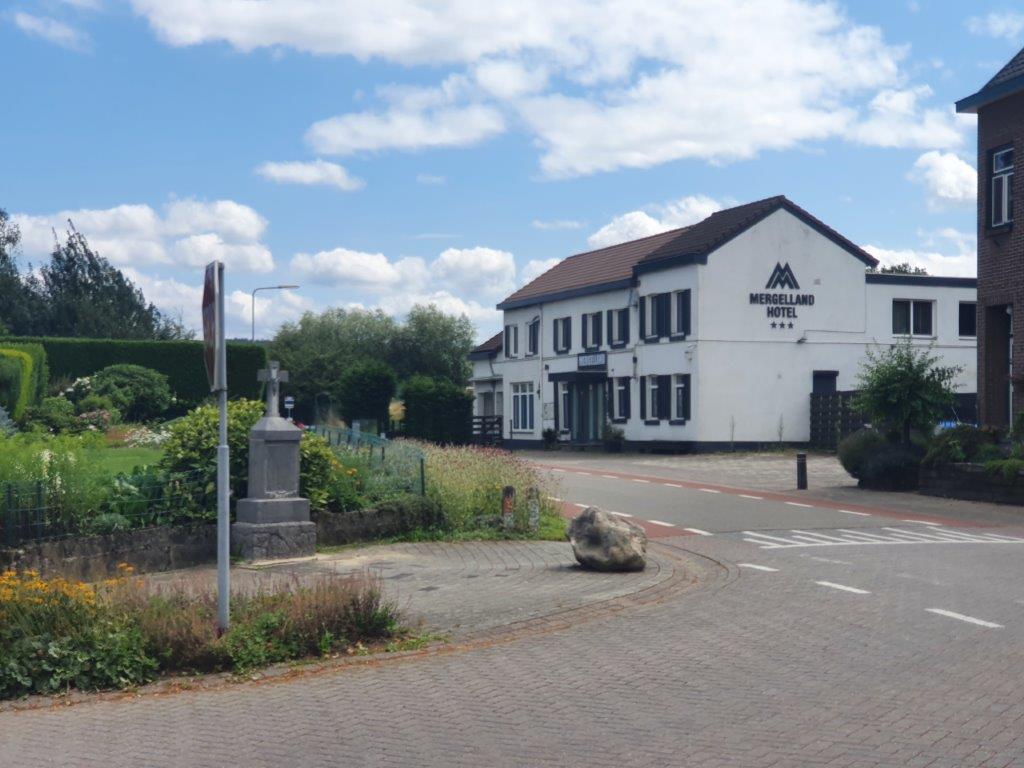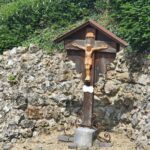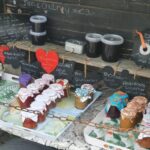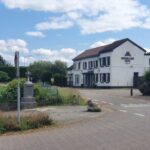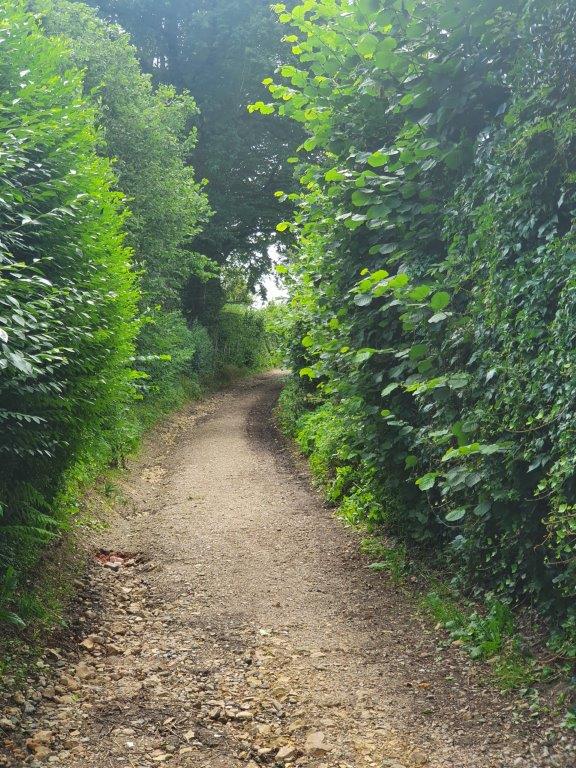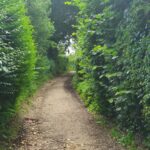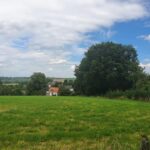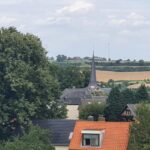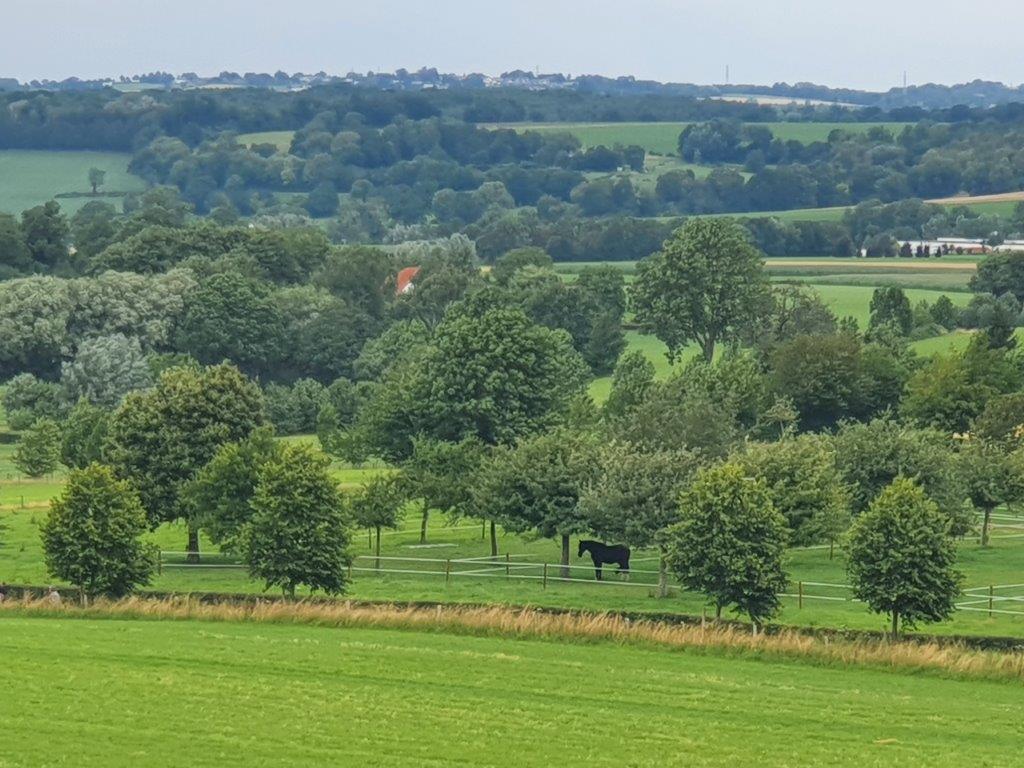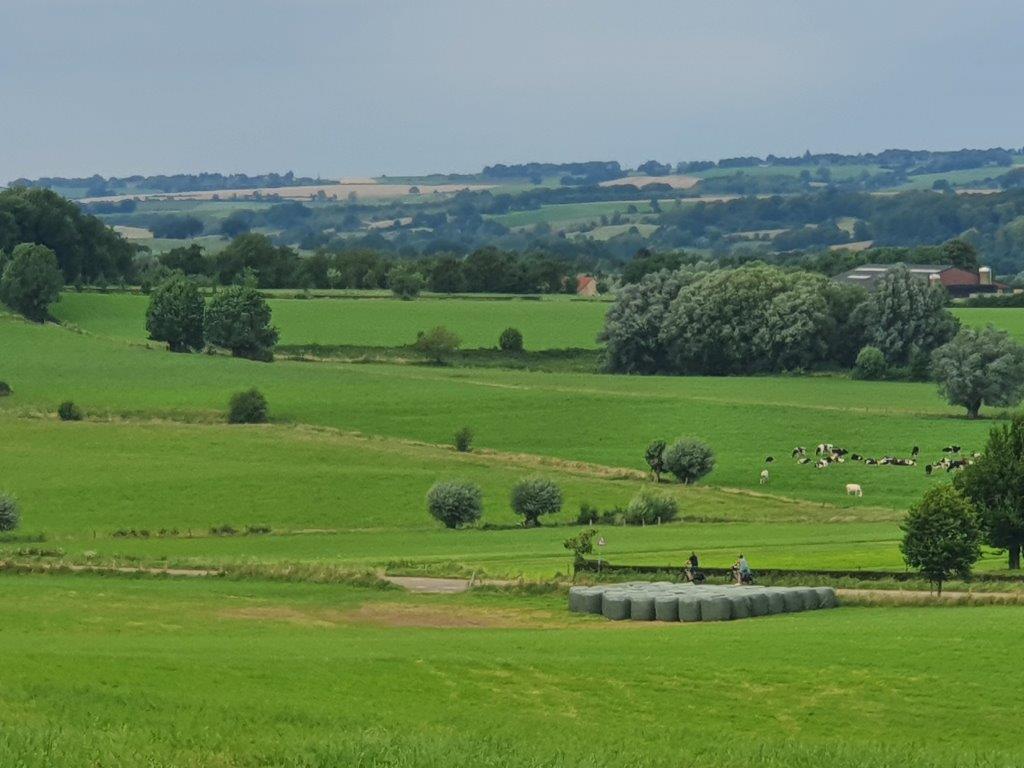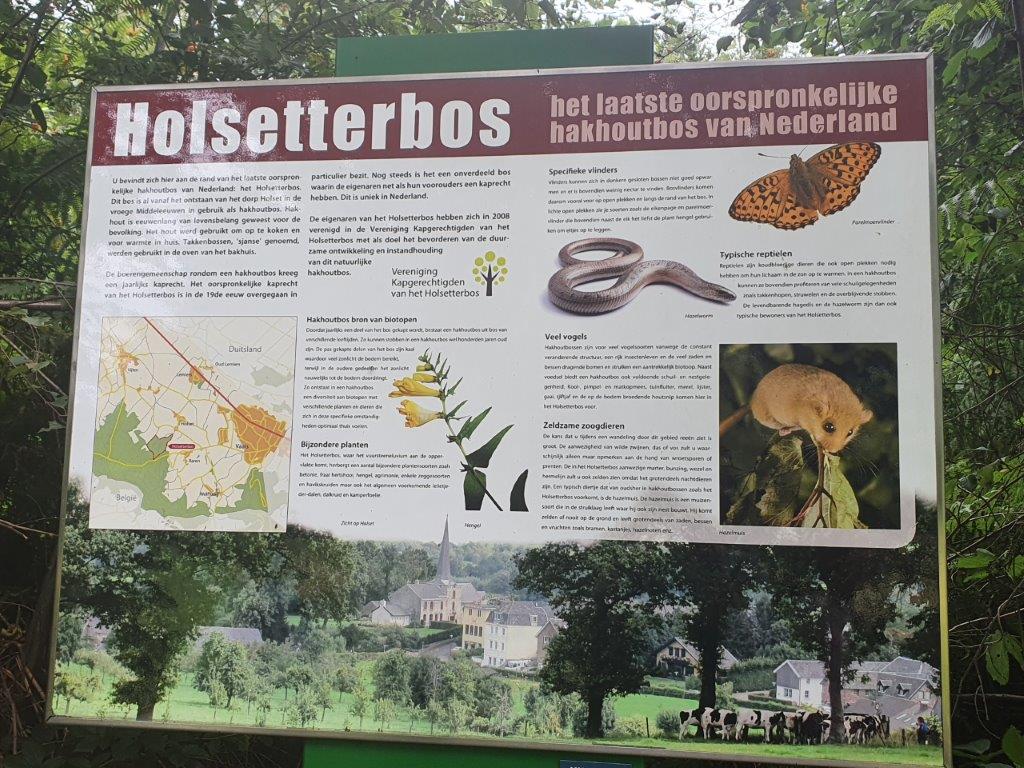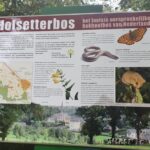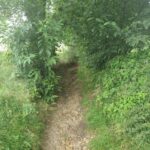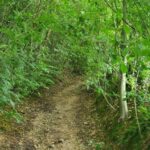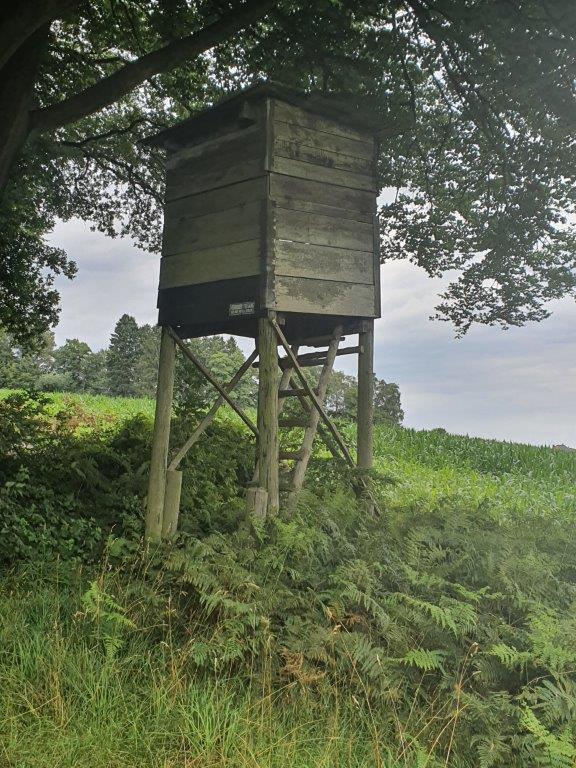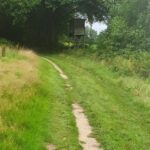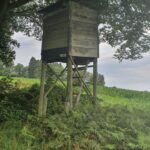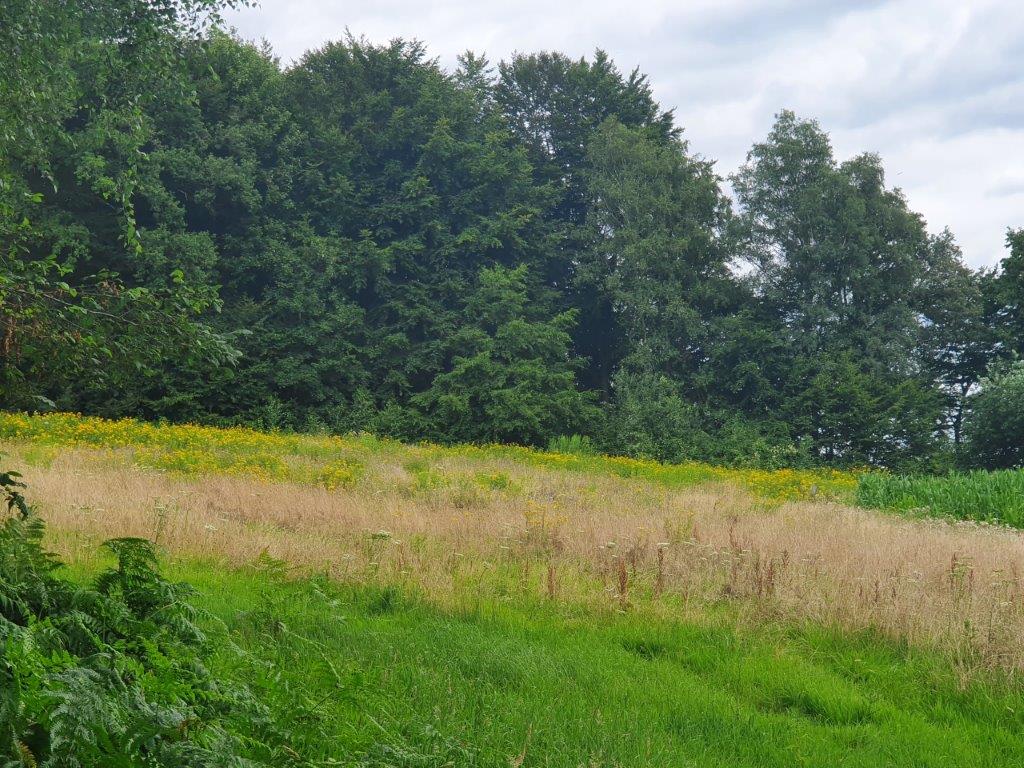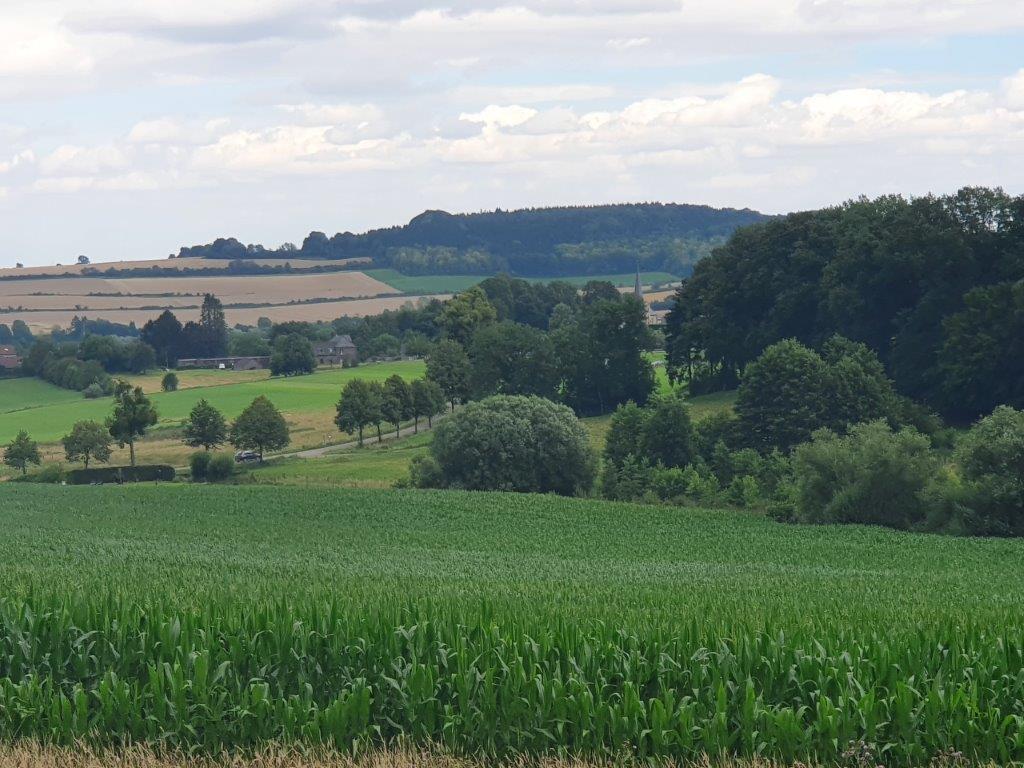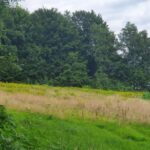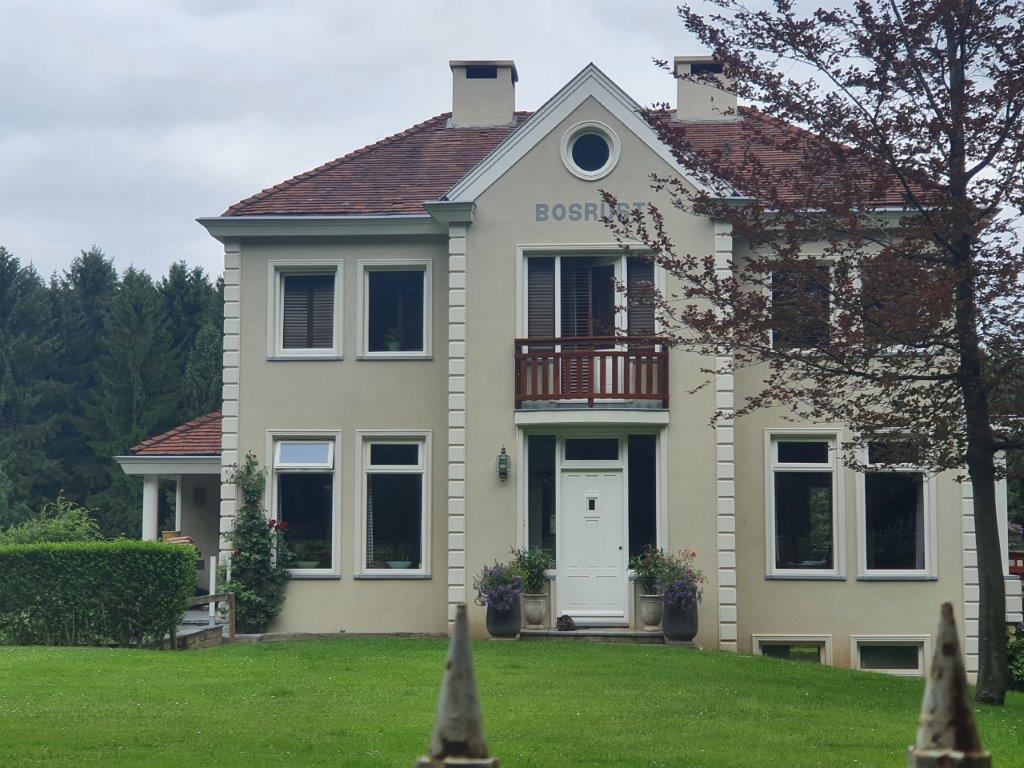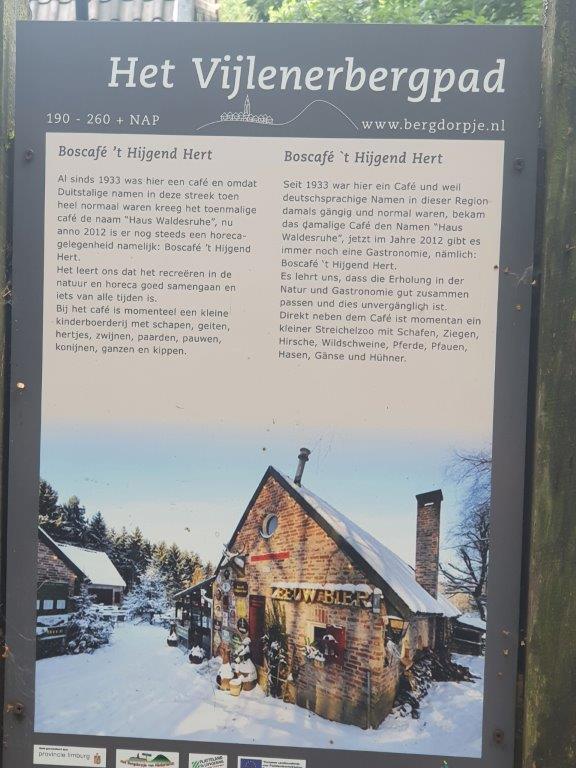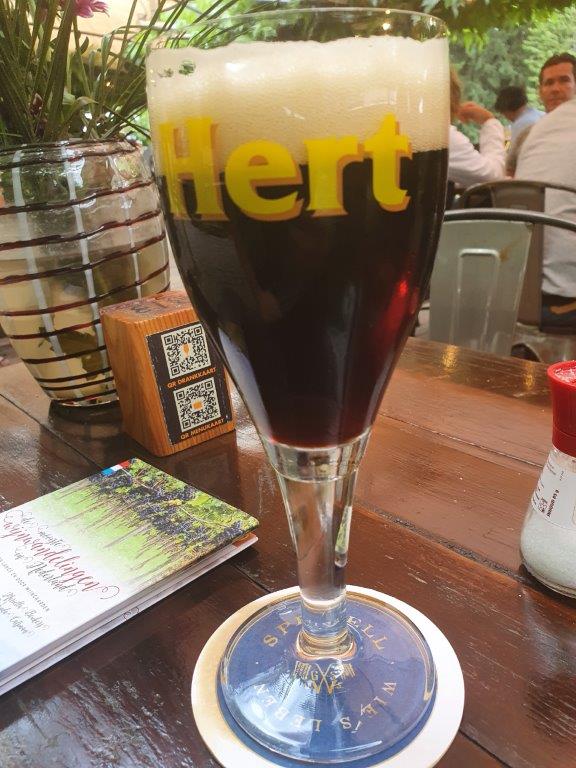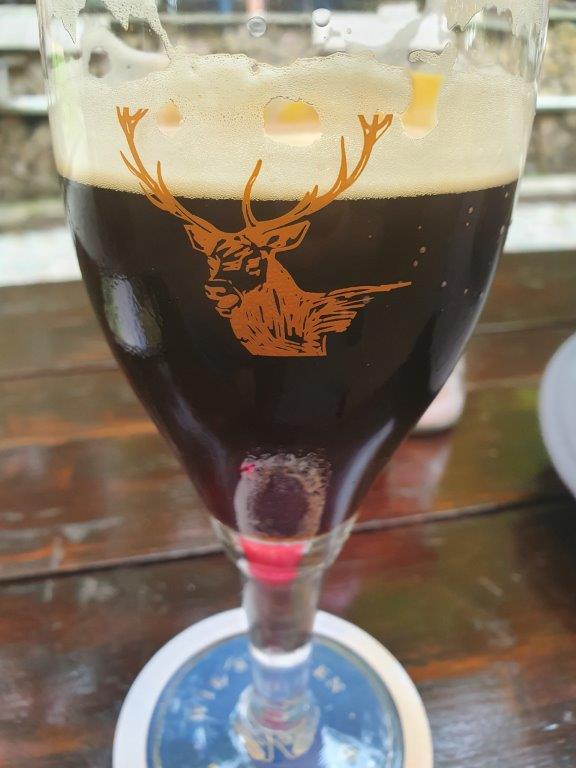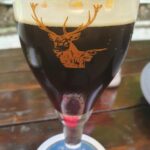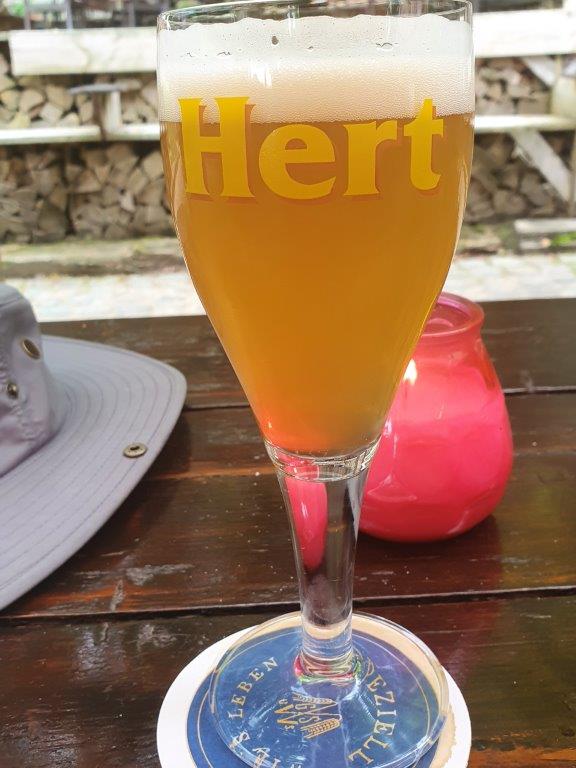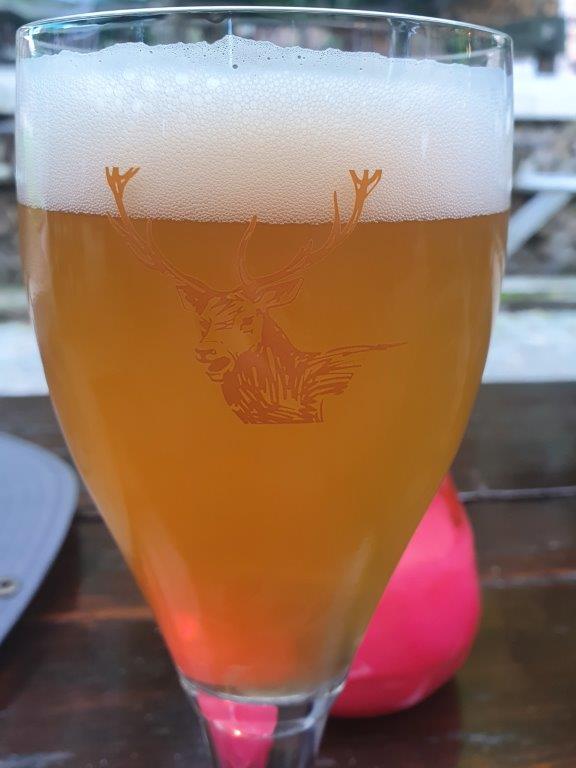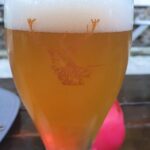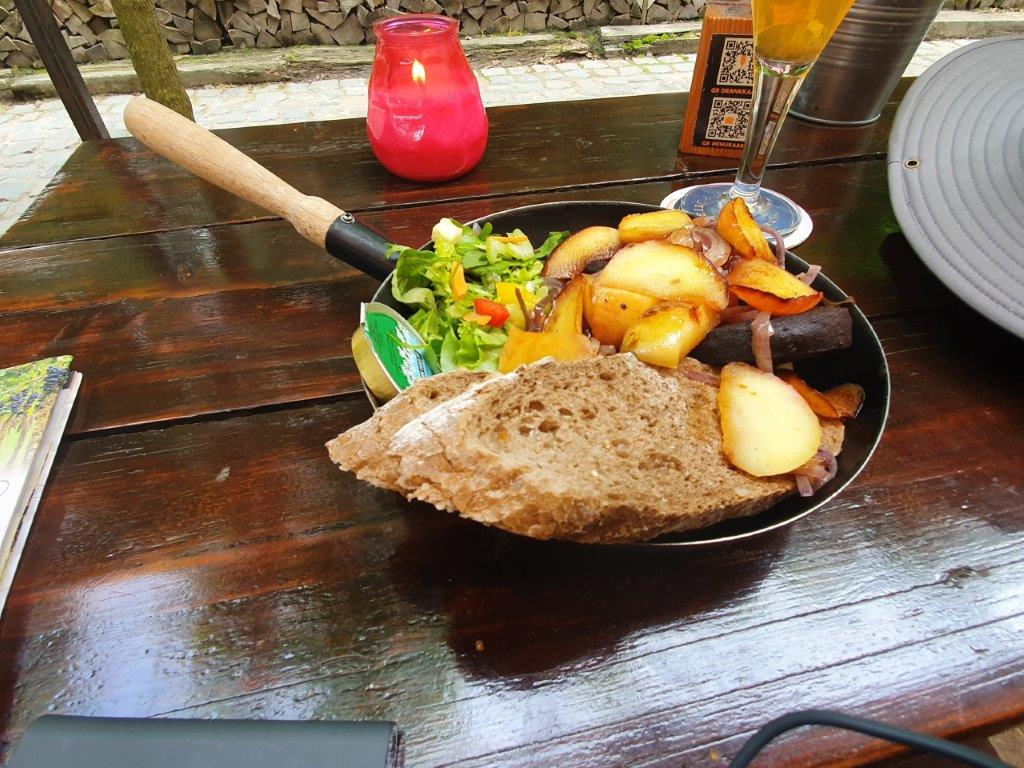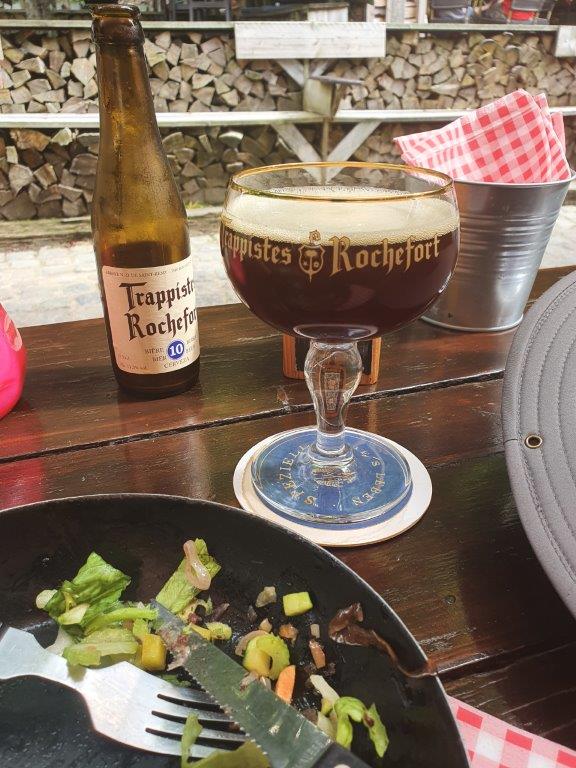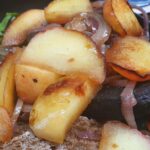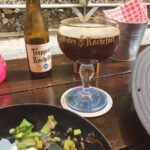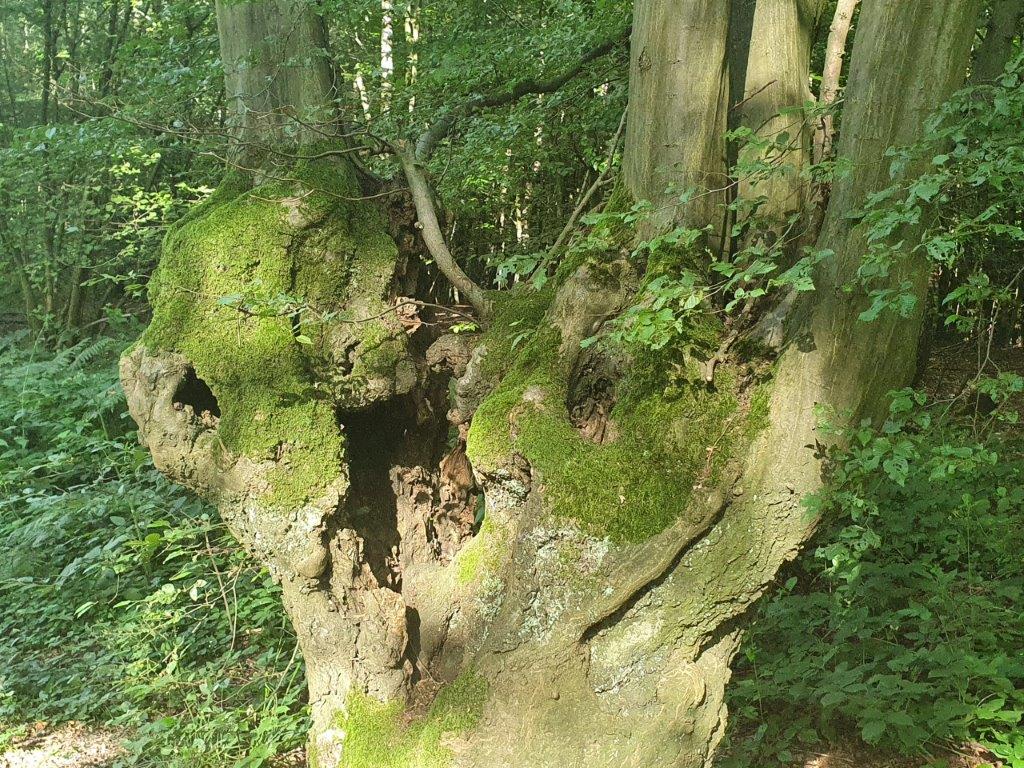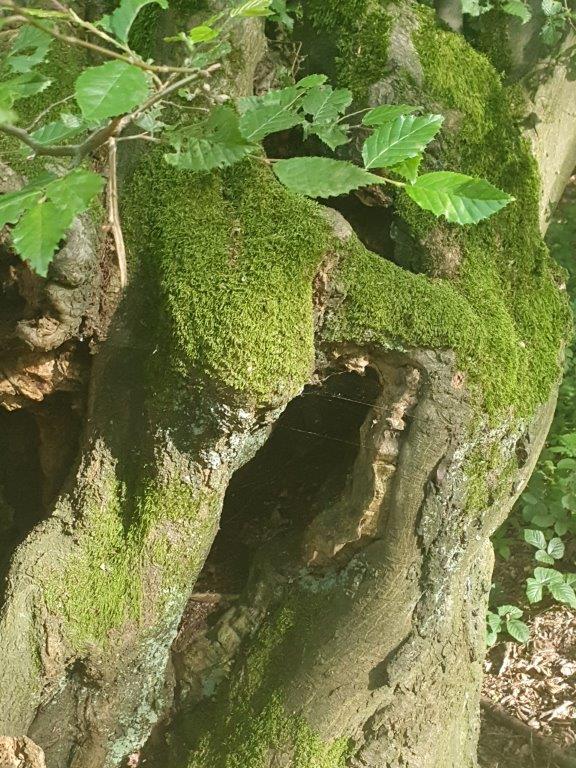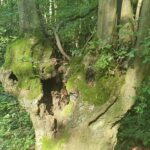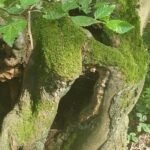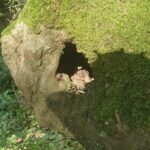Dutch Mountain Trail Deviation: C’est trés Français
This part of my walking travels in the utmost south of The Netherlands is one large deviation from my plan to follow the Dutch Mountain Trail (DMT). No worries though I will pick up on that trail later again.
 From the Hotel De Linde, The Wandelgek walked straight to the central square of the small village of Vijlen. This road follows a ridge in the landscape and thus there are views over the surrounding hills and the valley beneath.
From the Hotel De Linde, The Wandelgek walked straight to the central square of the small village of Vijlen. This road follows a ridge in the landscape and thus there are views over the surrounding hills and the valley beneath.
De mooiste wijnwandelingen in Nederland (The most beautiful wine estate walks in The Netherlands)
In 2019, The Wandelgek invested in a very interesting project by fellow travelblogger and walking addict @WandaWandelt (twitter/instagram), via a crowdfunding initiative. Through this initiative, she was trying to realize her dream of creating a walking guide. Specificly a walking guide with wine estate walks in The Netherlands. She took it upon her to write and check the 10 different walks, that were spread accross The Netherlands and she teamed up with viticulturist (vinoloog) Mariella Beukers who took it upon her to write the background stories about wine culture in The Netherlands, about the different wine estates that are visited during the walks and in general about the wine and the grapes.
The crowdfunding initiative was a great succes and in october of 2019 publisher Gegarandeerd Onregelmatig published the walking guide:
There were three compensations for the investors in the crowdfunding initiative: A signed copy of the guide, a selection of dutch wines from the engaged wine estates and a guided walk at one of the wine estates. That walk in the vicinity of Dieren, National Park De Veluwezoom and wine estate Hof van Dieren (number 4 in the guide), was good. In addition to the walk itself a wine tasting session at the wine estate was included.
During his walk on the DMT, or actually during one of the deviations from this walk, the opportunity rose to do another walk from this guide near the village of Vijlen. This blogpost and the next one are about that walk which is number 9 in the guide.
The Wandelgek walked from Hotel De Linde to the nearest location where he could join the Wine estate walk.
He visited Vijlen very long ago (2000) while hiking from Eupen to Epen (and deviating further to Vijlen), but in those days the church tower was being renovated…
See my blogpost: Walk 5: Heijenrath – Plaat – Epen – Vijlen (7,5km)
The church of Saint Martin
So this was the very 1st time he saw that tower uncovered.
The Sint-Martinuskerk is a Dutch church building in Vijlen in the South Limburg municipality of Vaals. It stands dominating along the main road of Vijlen at a height of 195.62 meters on top of the Vijlenberg, a hill in the village, through which it can be seen from afar. This makes it one of the highest parish churches in the Netherlands.
Around the church is a cemetery surrounded by a natural stone wall.
The church building is a national monument and dedicated to Saint Martin.
History
According to tradition, a small church was built on the site of the present church as early as the 7th century, founded by Saint Chlodulf of Metz. The medieval church was demolished around 1860.
The church was built in the period 1860-1862 and designed by Carl Weber. Due to probable financial problems, it took until 1879 before the church was finally finished.
Structure
Structure The style of the neo-Gothic church building is inspired by the Lower Rhine Gothic. The church is of the so-called Stufenhalle type, which means that the three naves of the church are under one continuous roof, with the side naves being narrower than the central nave. Stufenhallen of this kind were common in the area where Weber grew up and the Vijlen church is characteristic of his early work. The church has round pillars with plastered-wood cross rib vaults. The 65 meter high west tower is supported by diagonal buttresses. There are coupled reverberation holes in the highest section and the whole is crowned with an octagonal needle spire. The interior of the church is neo-Gothic.
Interior
After the visit to the church The Wandelgek joined the Wine estate walk at the Pastorijweg in the description in the guide.
For the exact walk description I refer to the guide which can be bought via this link:
 |
|
| De mooiste wijnwandelingen in Nederland of De mooiste wijnwandelingen in Nederland |
In this hiking guide, wine writer Mariëlla Beukers and route maker and hiking blogger Wanda Catsman find each other in an exceptional way. Mariëlla points out grape varieties, southern slopes and the tastiest Dutch wines while wine lovers are guided by Wanda through the most beautiful wine regions of the Netherlands. To finally look back on a beautiful day after a nice walk on a terrace with a good wine and to make plans for the next wine expedition. |
The start of the wine estate walk went through the village of Vijlen, but quickly the village was left behind and The Wandelgek found himself walking over sunken roads (dutch: holle wegen) and later dirt roads and grass trails. The municipality government of Vijlen had dispatched some workers to cut the abundant growing roadside weeds (Myself I prefer not to call those weeds). One of their cars was slowly driving and cutting weeds on such a sunken road, which made it impossible to overtake it. My walking speed and that of some other walkers was quicker than that of this vehicle, but got reduced considerable until the sunken road ended at a crossroads.
The section of the walk was across the fields of this high plateau upon which Vijlen was located. The roadsides were full of beautiful flowers…
The view around was amazing and even reached as far as the Vaalserberg, upon whose summit The Wandelgek had been two days ago. In one of the pics below you can see the panoramic tower on top of the Vaalserberg.
Some roads and paths and trails went straight through agricultural areas and between the trees far away, The Wandelgek noticed the turrets of Castle Oud Lemiers peeking above the foliage…
At a merge of two roads was a bench and it looked really inviting, standing there empty in the morning sunlight as the sky had turned blue. The roadsides were in full bloom and the beautiful flowers attracted insects like bees, bumblebees and butterflies…
The Wandelgek had now reduced his walking speed to that of the weed cutting vehicle, not because it was still in front of him, but simply because he wanted to get rid of the feeling that he had to be somewhere at a specific date and time. He wanted to feel lost out of free will.
I really love how this next photo turned out. Those sunlight reflections and the green and blue are wonderful…
The dutch province of Limburg is the only province that has lots of these German style half-timbered houses. They look absolutely gorgeous in a rural landscape…
Harlesserbeek
As The Wandelgek was passing through the tiny hamlet of Harles (which really sounded french to him), he crossed the Harlesserbeek (The Harles brook), which meanders through the rather empty agicultural landscape and is visible from a distance, because of the trees growing on its embankments…
The Harleserbeek is a stream in Dutch South Limburg. At the foot of the Vijlenerbossen in the vicinity south of the hamlet of Harles, it rises in the grasslands and after a few kilometers it flows into the Selzerbeek northwest of the village of Lemiers. The creek flows in a northeasterly direction.
The next pics show how the water is regulated and drained towards larger streams and finally towards the River Maas. Similar drainage tubes can be found on the hill slopes and it is very clear that this drainage system is far from sufficient, to cope with the large floods that had occured a few weeks earlier in this area. These small brooks easily flood and although that is not a total disaster in rural areas, it is really dangerous near hamlets, villages or cities…
The wine estate now came near the village of Holset. The last section of the walk before Holset was going through another field and far away beyond the field The Wandelgek could see the church tower of Holset.
Halfway through the field, the trail started to run through a vinyard. This was a vinyard of the wine estate of…
Domein Holset (Holset estate)
As the observant reader might have noticed, The “Living like a god in France”-aspect of this deviation is slowly beginning to take shape 😉
Vijlen in a demarcated area near the town of the same name Vijlen in the Dutch municipality of Vaals. Protection of this appellation was requested on February 12, 2016 and the European Commission adopted the protection decision on November 5, 2018 and published seven days later.
Within the area, Vineyard St. Martinus is the oldest wine company. This company has been planting grape varieties in the area since 1988. Since 2009 Domain Holset is the second wine domain in the area.
Domein Holset is a Dutch wine estate in Holset (municipality of Vaals). The domain covers 8 hectares both in Holset and on the Vijlenerberg, of which 6.5 hectares are wine grapes. Domein Holset specializes in sparkling wines, including the Brut van Holset.
The Wandelgek 1st visited one of the areas where the grapes were grown…
…and then he sat down on a bench overlooking the area, to do a small wine tasting 😀
At Domein Holset, surrounded by grapes, they also have guest rooms…
Beneath is an explanation in dutch of what a good wine tasting is about. Where do you need to put attention too while tasting wine?
The 2nd half of the explanation is about the three wines that are featured in this wine tasting:
- The Brut of Holset
- The Lady of Holset
- The Prince of Holset
All of these wines were sparkling white wines…
I can honestly say that THIS was the moment where The Wandelgek began to feel like living the life of a god in France…
It is not an obvious thing that The Netherlands has its own vinyards and wines. The Netherlands were always located too north for most grapes to grow succesfully and even now in some years the grape harvests get ruined by non-suitable weather.
The 1st vinyards started south of Maastricht, but nowadays there are vinyards far more north too, hence the wine estate walking guide. The Wandelgek favored The Prince and ordered one full glass of that wine, before getting on with the walk…
After the wine tasting, The Wandelgek visited the shop where all wines could be bought…
Then it was time to start walking again. The Wandelgek 1st visited a beatiful area of grapes to make some pictures…
Then he returned to the path and walked on towards the village of Holset…
Holset
Holset is a small village in the Dutch province of Limburg. It is located in the municipality of Vaals, about 2 km west of the town of Vaals itself. Holset is about 15 minutes by car from Aachen, just inside the Dutch border in South Limburg.
Holset has about 120 inhabitants, a vinyard, a church, hotel, bed-and-breakfast, and pub.
History
The history of Holset started before the Common Era. On the small hill is the Lambertus-church, 2000 years ago there stood a temple of the Eburons (who defeated Caesar’s armies). Caesar took terrible revenge and destroyed the Eburons and destroyed the temple.
Around 360 the bishop of Maastricht came to Holset to convert the population to Christianity. Some centuries later a church was built there. The Lambertus-church became popular for the marriages and a place of pilgrimage to the holy Genoveva of France (against eye-diseases and skin-rashes, esp. 18th century).
Nature
Holset is a refuge for the rare Common Midwife Toad that used to be common all over Europe and is on the red list today. The Limburgish name for the toad, “Klükske”, refers to their sound during mating season, which is similar to that of a tiny bell.
In front of the Herberg Oud Holset (Old Holset Inn) is a statue of a lustful woman, surrounded by what seem to be young cupids.
A bit further from the center The Wandelgek stumbled upon this funny, little bookstore, named after Harry Potter’s friend Hermione who was a bit of a booknerd.
The Wandelgek followed the road to the outskirts of the village and passed another road cross and a small market stall jammed with homemade local products like jams and chutneys
Then he took the road up towards the Holsetter bos and after some climbing, which was a piece of cake without the large backpack, he could enjoy the views over Holset…
…and over the valley. Far away on the plateau was the Saint Martin’s church of Vijlen clearly visible.
Then The Wandelgek entered the Holsetterbos again …
…and passed this small watch tower.
The forest area is that of the Vijlenerbos, of which the Holsetterbos is a subdivision.
The Vijlenerbos
The Vijlenerbos is an approximately 650 ha large forest and nature reserve near the town of Vijlen in the Dutch Limburg municipality of Vaals. Small parts of the Belgian municipality of Blieberg are located on the southern edge of the forest. The Vijlenerbos actually consists of several forests, all of which are owned by Staatsbosbeheer; it is therefore sometimes referred to as the Vijlenerbossen.
Location
The Vijlenerbos is an elongated forest area that extends over a length of approximately 8 km between Epen and the Drielandenpunt near Vaals. The forest borders Belgium over a length of about 5 km and Germany over about 1 km. Sub-areas of the forest are usually named after nearby villages and hamlets. From west to east: the Elrekenbos (near Elzet and Rott), the actual Vijlenerbos, the Kerperbos, the Holsetterbos (near Holset), the Malensbos (south of the Epenerbaan), the Schimperbos (southwest of Wolfhaag) and the also wooded Vaalserberg. The Vaalserberg connects both on Belgian and German territory with comparable slope forests, such as the Aachener Wald and the Preusbos. Together, these forests are referred to as the Drielandenbos.
About 200 ha of the highest parts of the forest between Vijlen, Epen and Vaals consist of fairly flat plateaus, the rest consists of slopes. The fairly extensive sloped forests are characterized by significant differences in height of about 100 meters. The highest point is the Drielandenpunt with 323 meters, the lowest is not far from the Geul at about 150 meters.
In the lower parts there are a number of sources, from which streams arise in all directions, such as the Cottesserbeek, the Berversbergbeek, the Klitserbeek, the Hermensbeek, the Lombergbeek, the Harleserbeek, the Hermansbeek and the Zieversbeek.
History
The area in which the Vijlenerbos is located was already inhabited in prehistoric times, as evidenced by the various burial mounds, including a burial mound on the Vaalserberg.
An iron smelter near Cottessen dates from Roman times. From the Middle Ages there is more information about the history of the area. The names Vijlenerbosch, Malensbosch, Elsetterbosch, Kerperbosch and Holsetterbosch are mentioned in old charters. It is stated about the Holsetterbos that it is communal property (because of the cutting rights).
From 1940, large areas have been replanted by Staatsbosbeheer, mainly with hardwood species that occur naturally in these forests.
In 1951 a large boulder was removed from the Vijlenerbos and placed in Valkenburg as the Dikke Kei.
The Wandelgek now made a shortcut through the woods towards Boscafe Het Hijgend Hert, for lunch and some beer. He passed the villa Bosrust (meaning something like: “The tranquility of the wood”).
He then arrived at the wood cafe which. According to the sign beneath was Huis Bosrust (under the German language name Hause Waldruhe already a cafe in 1933. In those days German names were quite common in this area. Nowadays there is another cafe at Boscafé Het Hijgend Hert, located a bit further down the path…
The Wandelgek arrived at the wood café and sat down at a table on the terrace.
The Wandelgek started with a Hert Bruin, which is a beer which is brewed with syrup from the region and is available here on tap as Hert Bruin. It has an 8% alcohol volume (in the pics below it is the beer with the larger foamhead).
He now ordered the darker, a bit stout like house beer: Stout Hert, which is a classic Milkstout of 6.2%, available as draught beer from the barrel (in the pics below it is the beer with almost no foam head and the deer image on the glass)…
…and then a Hert Blond, which is a blond, 7.5% alcohol volume, top-fermented beer that is brewed especially for forest café ‘t Hijgend Hert. It is shown on both pics below.
Then it was time for a sturdy local dish named blackpudding with apple. It is a typical dish from Limburg, because in this province there are a lot of fruit trees. This is why dishes like blackpudding with apple (or the more exotic variant with pineapple) or products like fruit jam and apple and pear syrup are produced a lot in the area. Lots of the local beers have syrup or fruit as an ingredient. Not only apples and pears but also cherries. Another famous local product is the flan, topped with loads of fresh fruit, like cherries or gooseberries or plums. In upcoming blogposts of my DMT walk, I will also pass through some fruit tree orchards.
But for now The Wandelgek went for blackpudding with apple accompanied by a Trappistes Rochefort 10, Belgian beer…
This dish is best made with blackpudding from the Province of Limburg, which has a very fine structure. The Wandelgek nowadays lives far more north in the city of Deventer which is near to the region of Twente. There is also Twentse blackpudding, but this is much less fine in structure. Although this blackpudding is delicious too and it can be used for the recipe too, it does taste less good.
After this very sturdy lunch, The Wandelgek decided to stop his walk and return to the hotel. The wine estate walk was not finished yet, but he decided to finish that walk the day after, because the wine and beer tasted a bit too well😉🙃Hips.
He walked through the forest towards Vijlen and ended the day with a modest dinner of onion soup…
…and carpaccio…
Both tasted and looked delicious.
Then it was time to retreat to the room for a good night rest.



